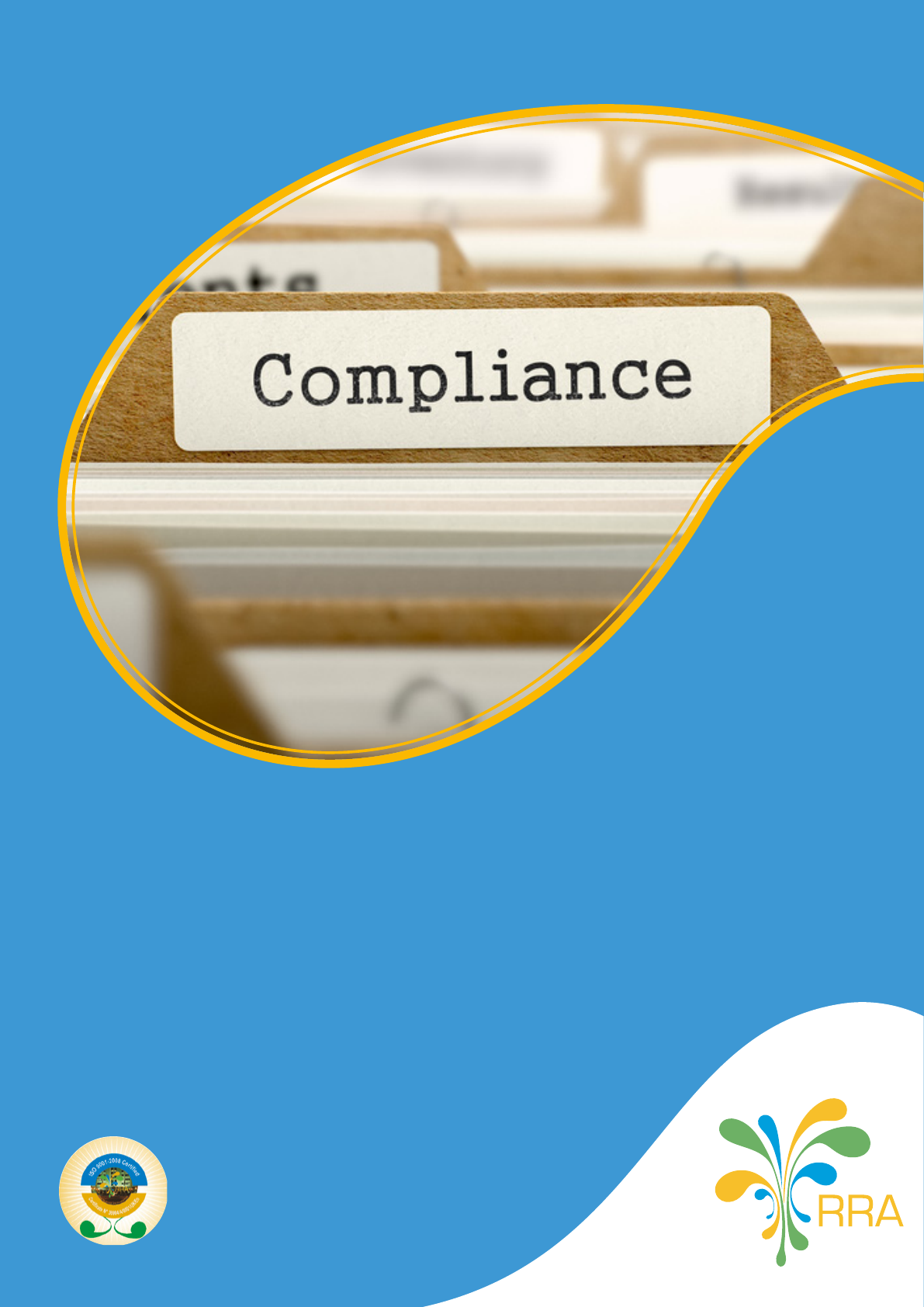
RWANDA REVENUE AUTHORITY
COMPLIANCE IMPROVEMENT PLAN
2016 - 2017
June, 2016
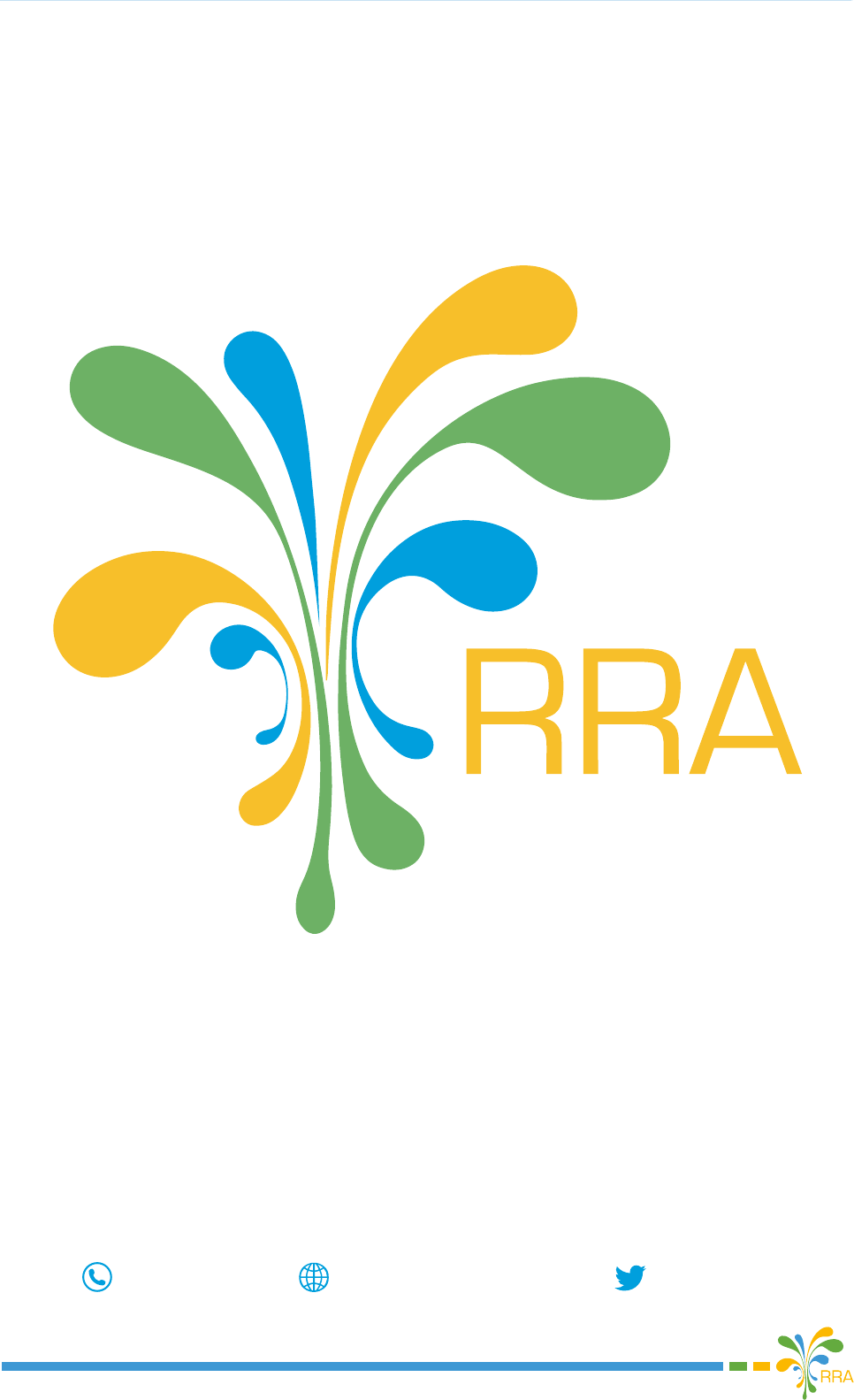
2
Compliance Improvement Plan
www.rra.gov.rw
3004 @rrainfo

3
Compliance Improvement Plan
FOREWORD
Citizens of Rwanda,
We are proud to introduce the inaugural RRA Compliance Improvement Plan, a high-level
overview of our plans for the next nancial year to further improve compliance with tax
legislation.
We plan to do this by focusing particular attention on areas which our research and risk
analysis model and tools have shown pose a signicantly higher risk of non-compliance.
By focusing on these issues we believe we can make a signicant impact on increasing the
fairness of the tax system.
RRA is currently guided in its eorts by a Strategic Plan that covers the period of 2015 -
2018. That Plan also provides for our commitment to developing a separate Compliance
Strategy through which we can use our resources more eectively in ensuring voluntary
compliance of our population of taxpayers.
I would like to thank the IMF for their technical assistance in the development of this strategy,
particularly Mr. Joshua Aslertt, who provided assistance regarding developing a Compliance
Risk Analysis Model and Tool, based on the compliance strategy best principles published
by the OECD for use by both developing and modern tax administrations.
Our tax system is based on the principles of self-assessment and voluntary compliance.
Voluntary compliance relies on taxpayers’ honesty in determining their tax obligations and
accurate reporting.
We believe that if you are making your fair contribution and doing the right thing, you deserve
to know that everyone else is doing so too! As we make it easier for all taxpayers to meet
their obligations quickly, easily and cost-eciently, we must make equally sure that those
who don’t pay their fair share and don’t abide by the rules are brought into the fold.
We believe that the most eective way to gain and maintain voluntary compliance is through
building a relationship of mutual trust and respect between the tax administration and the
taxpayers of Rwanda. That is why our Strategy includes an emphasis on improving our
service delivery to the public so that we can meet your expectations and provide the service
you deserve.
I hope that you will join RRA in ensuring that our tax system works fairly and that everyone
pays their fair share. In this way, the Government of Rwanda can trust to have sucient
revenues to enabling it to meet citizens’ expectation in terms of public goods and services
supply, hence leading to self reliance.
Sincerely,
Richard TUSABE
Commissioner General

4
Compliance Improvement Plan
CONTENTS
FOREWORD
1. GENERAL INTRODUCTION
• 1.1 Introduction
• 1.2 Background
• 1.3 Compliance Model
2. OUR COMPLIANCE IMPROVEMENT PLAN
• 2.1 Methods used to determine non compliance
2.1.1 Detecting non Compliance using Macroeconomic Data
2.1.2 Risk Dierentiation Framework
2.1.3 Detecting non compliant business sectors
• 2.2 PRIORITY AREAS AT A GLANCE
2.2.1 Compliance Strategy: Construction
2.2.2 Compliance Strategy Action Plan: Construction
2.2.3 Compliance Strategy: Hotels
2.2.4 Compliance Strategy Action Plan: Hotels
2.2.5 Compliance Strategy: Large Taxpayers
2.2.6 Compliance Strategy Action Plan: LTO
2.2.7 Compliance Strategy: Medium Taxpayers
2.2.8 Compliance Strategy Action Plan: MEDIUM
2.2.9 Compliance Strategy: Small Taxpayers
2.2.10 Compliance Strategy Action Plan: Small Taxpayers
3. MONITORING AND EVALUATION FRAMEWORK
4. CONCLUSION
LIST OF FIGURES
FIGURE 1 RRA RISK DIFFERENTIATION FRAMEWORK
FIGURE 2 COMPLIANCE MODEL
FIGURE 3 APPROACH TO DEVELOP COMPLIANCE IMPROVEMENT PLAN
FIGURE 4 REGRESSION ANALYSIS
FIGURE 5 LIST OF METRICS DEVELOPED
3
6
6
7
8
8
9
10
11
11
16
17
18
23
24
31
36
37
43
44
45
45

5
Compliance Improvement Plan
LIST OF ABBREVIATIONS
RRA: Rwanda Revenue Authority
TADAT: Tax Administration Diagnostic Assessment Tool
TA: Technical Assistance
RDF: Risk Dierentiation Framework
PSF: Private Sector Federation
IMF: International Monetary Fund
GDP: Gross Domestic Product
ISIC: International Standard Industrial Classication
ATAR: Association of Tax Advisors in Rwanda
ICPAR: Institute of Certied Public Accounts in Rwanda
TPS: Taxpayer Service
CRMMD: Corporate Risk Management and Modernization Department
CRMC: Corporate Risk Management Committee
DTD: Domestic Taxes Department

6
Compliance Improvement Plan
1. GENERAL INTRODUCTION
1.1 INTRODUCTION
The mission of Rwanda Revenue Authority (RRA) is to “Mobilize revenue for economic
development through ecient and equitable services that promote business growth.” RRA
is a quasi-autonomous body charged with the task of assessing, collecting, and accounting
for tax, customs and other specied revenues. This is achieved through enhancing taxpayer’s
compliance as per the RRA rst priority in the Strategic Plan for 2015/16-2017/2018.
Dierent studies categorize Taxpayer’s compliance in two perspective models (economic
Deterrence model and scal and social psychology model). Economic Deterrence model is
based on the concept that the risk of detection and punishment will improve compliance
behavior. Whereas scal and social psychology models inductively examine the attitudes
and beliefs of taxpayers in order to predict actual behavior.
The rationale for enhancing taxpayer’s compliance derives from the primary goal of the
RRA which is to collect taxes and duties payable in accordance with the law and do this
in such a manner that will sustain condence in the tax system and its administration. The
actions of taxpayers, whether due to ignorance, carelessness, recklessness or deliberate
evasion, as well as weaknesses in the tax administration mean that instances of failure to
comply with the law are inevitable. As such, RRA will endeavor to promote strategies and
structures that ensure non-compliance with the tax law is kept to a minimum level.
The overall objective of this compliance improvement plan is to facilitate the compliance
process by creating a compliance environment in which easy administrative procedures,
systematic guidance of the taxpayers and a variety of incentives will make the taxpayers
comply with their tax obligations to the highest extent possible.
During the period of this compliance improvement plan, RRA eorts will focus on the
expansion of the tax base and collection of the appropriate amount of tax from taxpayers.
This is going to be achieved through undertaking various initiatives targeting to inuencing
the current taxpayers’ compliance behavior and strong enforcement measures for intentional
non compliance attitude leading to reduction of the tax gap.
1.2. BACKGROUND
The TADAT assessment report of August 2015 identied unsystematic impact assessment
of compliance management interventions across the RRA. Some weak areas were pointed
out including but not limited to: registration, ling, payment and accuracy reporting and there
is a need for RRA to understand the causes of non-compliant behavior of taxpayer and take
adequate corrective measures. The International experience suggests that most types of
non compliance are best treated by: i) understanding underlying causes; ii) making groups
of taxpayers aware that their noncompliant behavior is known; iii) adopting a cooperative
approach to reconciling; and iv) demonstrating the seriousness of the administration
through small numbers of high-prole enforcement activities.
It is in this context that RRA with IMF TA had developed Compliance Risk Analysis Model
and Tool based on best practices from Australia Tax Oce. The adopted model will help the
tax administration to maintain a best and sustainable way of improving taxpayer’s attitude
and behavior towards fullling their obligations.
The adopted following Risk Dierentiation Framework (RDF) is made up of four dierent
quadrants (groups) that contain taxpayers with common behaviors as per risk perspective:
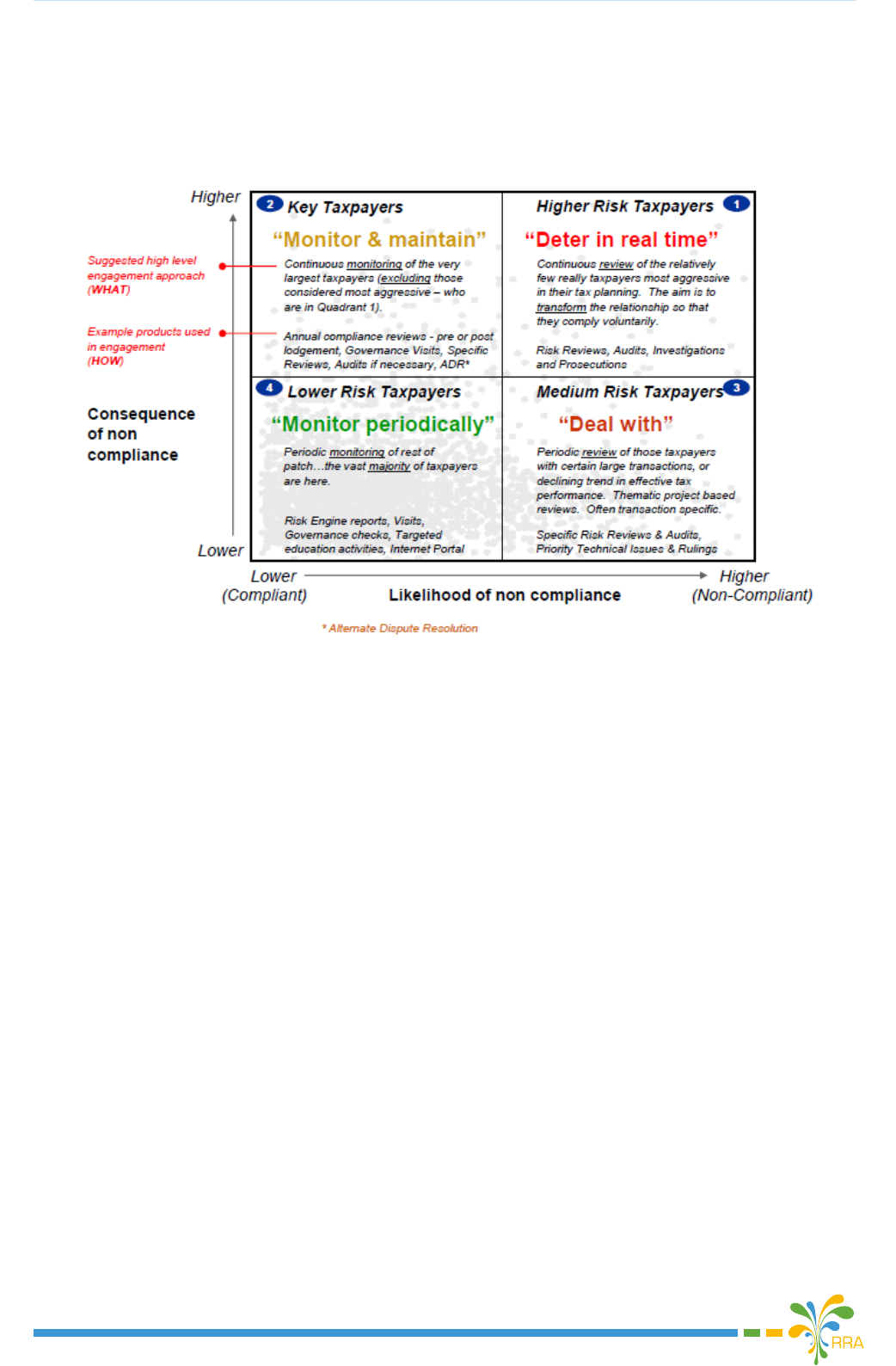
7
Compliance Improvement Plan
Quadrant 1: Higher Risk Taxpayers
Quadrant 2: Key Taxpayers
Quadrant 3: Medium Risk Taxpayers
Quadrant 4: Lower Risk Taxpayers
Figure 1 RRA Risk Dierentiation Framework
The above RDF is based on the premise that our risk management approach to tax
compliance should take account of our perception of both the:
i) estimated likelihood of you having a tax position that we disagree with, or you (through
error or omission) have misreported your tax obligations (as evidenced by your behavior,
approach to business activities, governance, and compliance with tax laws),
ii) Consequences of that potential non-compliance (nancial impact, relative inuence,
impact on community condence).
1.3. COMPLIANCE MODEL
The compliance model below provides a structured way to better understand what
motivates people to comply, or not comply, and it assists us to tailor our responses and
interventions so that we can inuence taxpayer behavior in a positive way. It recognizes
that taxpayers are not a homogenous group and their circumstances can change over time.
The left side of the model identies the wide variety of factors that can inuence the extent
to which a taxpayer chooses or is able to meet their obligations, including business,
industry, sociological, economic and psychological factors. This mix of environmental
factors is represented by the acronym BISEP: B = business prole, I = industry factors, S =
sociological factors, E = economic factors and P = psychological factors.
The right side of the model reects the dierent taxpayer attitudes to compliance, ranging
from ‘willing to do the right thing’ to ‘have decided not to comply’, and the corresponding
ATO RDF TreatmentStrategies

8
Compliance Improvement Plan
high level strategies that are most likely to eectively address those attitudes.
Figure 2 Compliance Model
The model advocates a deeper understanding of motivation, circumstances and
characteristics, so that assistance and enforcement actions can be tailored to promote
better compliance. The ultimate aim is to inuence as many taxpayers as possible to
move down the pyramid into the ‘willing to do the right thing’ zone. Analyzing compliance
behavior in this way assists us to address the actual causes of non-compliance rather than
the symptoms.
2. OUR COMPLIANCE IMPROVEMENT PLAN
2.1. METHODS USED TO DETERMINE NON COMPLIANCE
While the overall compliance climate is not good but showing improvement, we know
that we need to continuously focus our eorts on not just sustaining the levels of willing
compliance, but on creating a climate that is increasingly conducive to full compliance by
all taxpayers.
To do this we need to constantly monitor the compliance levels of taxpayers, traders
and other stakeholders in order to pin-point areas of high or low compliance and then to
understand the drivers of this good or bad behavior so that we can devise appropriate
strategies in line with our compliance approach to sustain or alter the behavior as required.
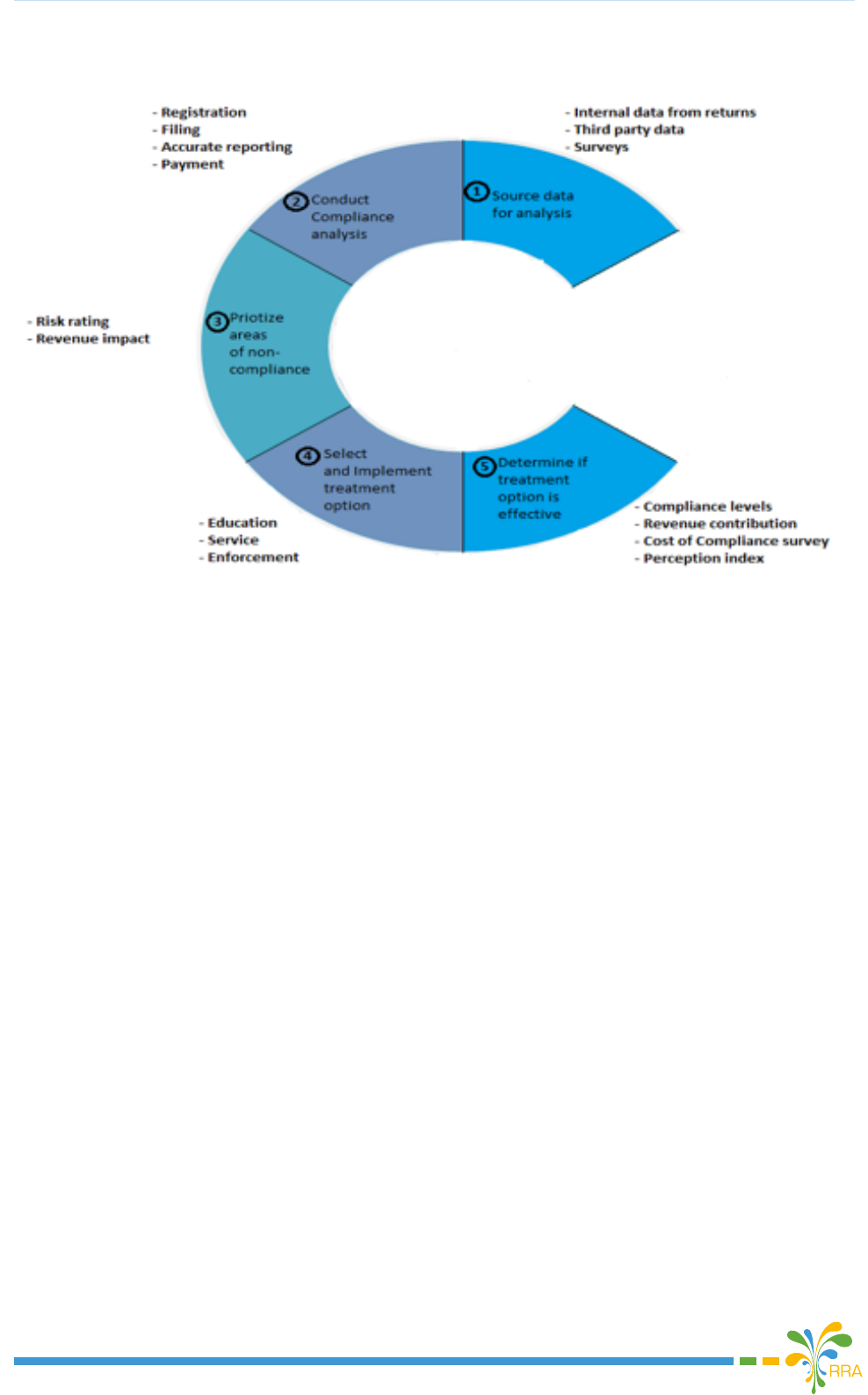
9
Compliance Improvement Plan
OUR APPROACH IN DEVELOPING THE COMPLIANCE STRATEGY
Figure 3 Approach to develop compliance improvement plan
How we select our priority areas:
To ensure our Compliance Improvement Plan is broad and inclusive, and that we explicitly
focus on changing the compliance landscape, we look beyond just basic above-the-line
risk assessments. This means that for each of our segments and sectors we consider:
The industry’s overall risk rating
The revenue risk posed by the industry
Specic lifecycle risks relating to registration, ling, accurate reporting and payment
Systemic legislation and policy gaps and risks
Which system optimization would have the biggest impact on compliance
Which education and empowerment initiatives would have the biggest impact on compliance
What leverage opportunities we have to maximize compliance
To select and prioritize areas for compliance improvement, we used the macroeconomic
approach to detect non compliance and RDF model methods on 2015 tax returns data to
classify taxpayers into dierent quadrants as described in previous pages.
2.1.1 DETECTING NON COMPLIANCE USING MACROECONOMIC DATA
The objective of using macro economic data while analyzing the level of compliance is
mainly to determine the underreporting of income by economic sectors. To achieve this
objective, one has to use the basic econometric model establishing the relationship among
taxes and GDP (expressed in nominal values), the latter being taken as a proxy of the tax
base. The basic model is given by the following formula:
ln TRt = ln β0 + β1 ln GDPt + εt
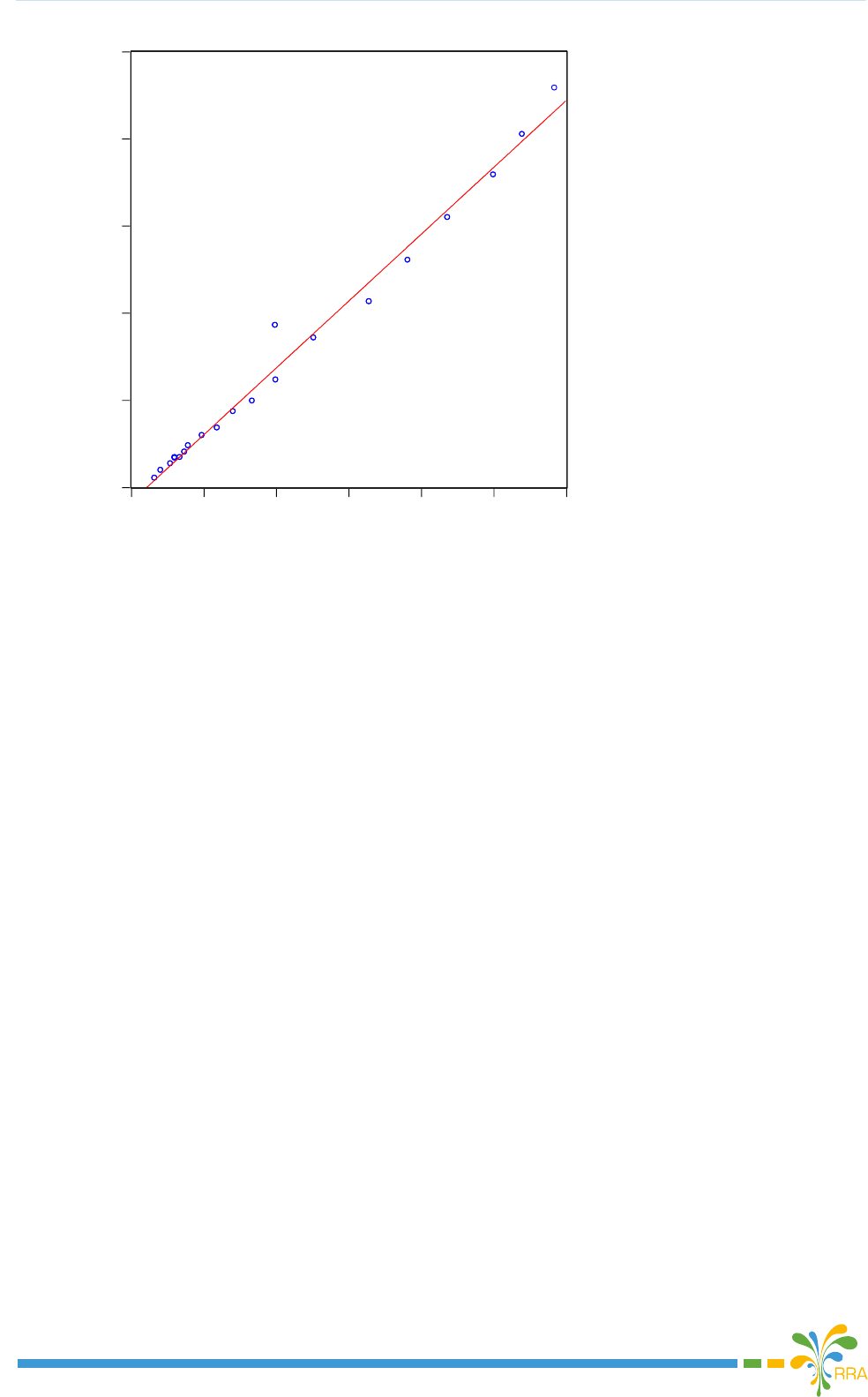
10
Compliance Improvement Plan
0
200
400
600
800
1,000
0 1,000 2,000 3,000 4,000 5,000
6,000
GDPN
TRN
Where: TRt is aggregated Tax Revenues in time t
GDPt is Gross Domestic Product in time t
εt is the Error Term or stochastic term
ln is natural logarithm
Figure 4 Regression Analysis
Tax revenues being a stochastic variable, one may easily point out that for 2014 and 2015
tax periods, the authority has collected revenues above the average which signicantly
conrm the good performance compared to previous tax periods under consideration.
Various empirical studies have shown that Rwanda has an elastic tax system, with an
overall elasticity estimated to 1.39% which implies that there is a way of increasing revenue
collections without necessarily introducing discretionary policy changes. The analysis
has also shown that except the import duty which the elasticity was estimated to 0.67%,
other tax heads were found elastic with elasticity estimated to 1.637%, 1.114%, 1.0147%
respectively for direct taxes, VAT and excise duty (BNR, Economic Review, Vol 8).
The detailed analysis of non compliance by tax head and by business sector will be more
useful after updating the tax registry as per ISIC requirement and most probably will be
included in the next compliance improvement plan.
2.1.2. RISK DIFFERENTIATION FRAMEWORK
To be aware of its own causes of non-compliant behavior of taxpayers, the tax administration
needs to stimulate compliance and prevent non-compliance. In order to attain that objective,
RDF tool helps to frame taxpayers’ risk to revenue using dierent metrics to measure and
calculate data for proling purpose.
The metrics listed below have been used for tax compliance.
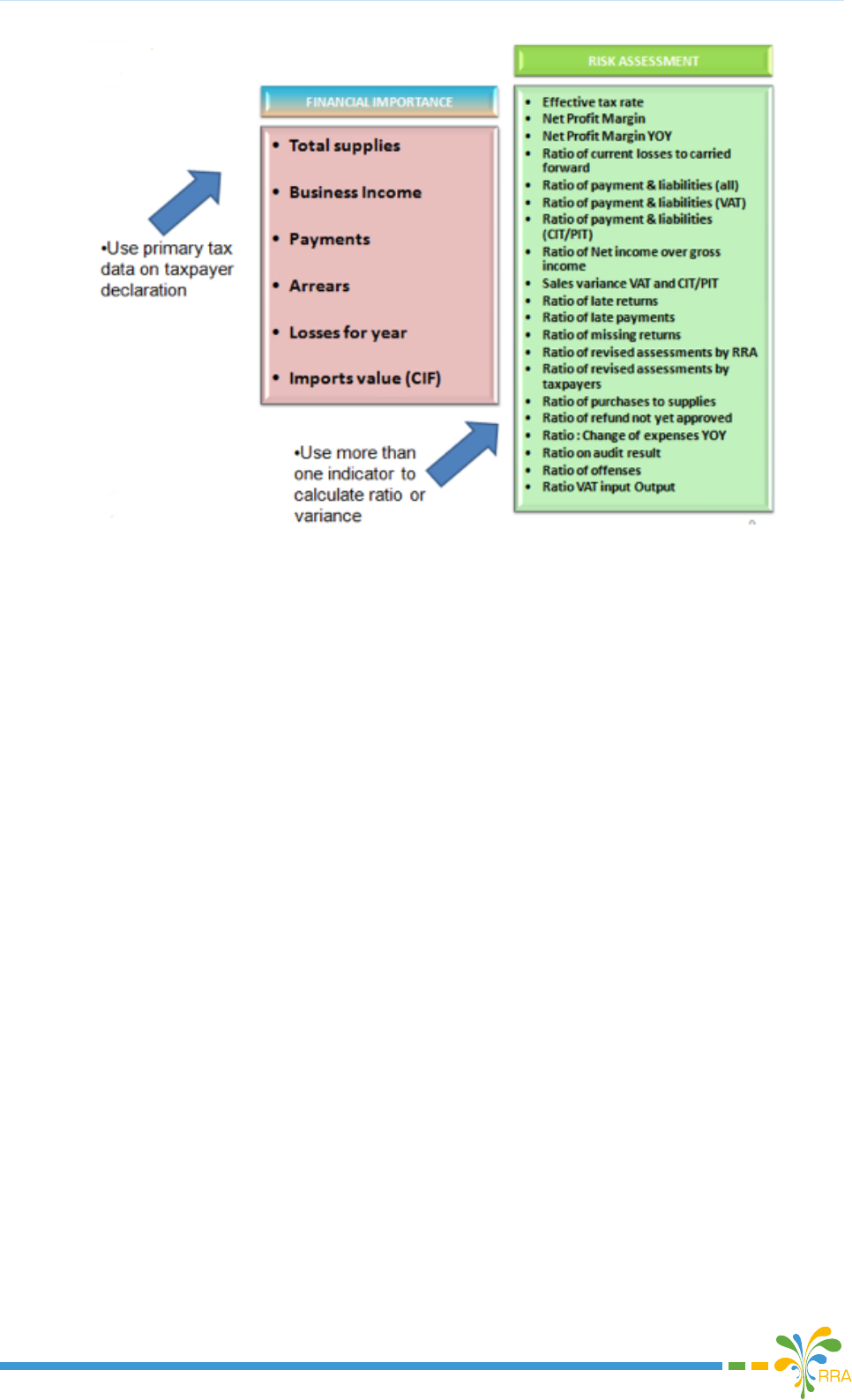
11
Compliance Improvement Plan
Figure 5 List of metrics developed
2.1.3. DETECTING NON COMPLIANT BUSINESS SECTORS
Apart from addressing the non compliance behavior of a specic group of taxpayers (large,
medium and small), we are targeting the two business sectors that we are found highly non
compliant namely construction and hotel sectors.
The recent study on business protability analysis where two metrics (Gross prot margin,
Pre-tax prot margin) were used and seven business sectors including transportation,
general commerce, hardware, construction, hotel, banking and insurance were covered,
ndings revealed that banking was the most protable industry with an average pre-tax
prot margin of 11.87% followed by hardware, general commerce and insurance industries
with an average pre-tax prot margin of 3.26%, 0.8% and 0.48% respectively.
The three last industries in protability were construction, transportation and hotels with an
average pre-tax prot margin of -2.9%, -8.4% and -14.4% respectively.
Based on the above ndings, RDF tool was used to extract data on the Hotel and Construction
sectors in order to analyze, prole and classify taxpayers into dierent dierentiation
quadrants as per their compliance levels.
2.2 PRIORITY AREAS AT A GLANCE
Using the approaches and methods discussed above, over the next nancial year we will
specically focus on two following sectors across Large, Medium and Small taxpayers:
1. Construction sector
2. Hotel Sector
Broadly we will also focus on the remaining sectors in the three mentioned segments.
Therefore, we have developed Compliance Strategies for target sectors: Construction and
Hotel, Large, Medium and Small Taxpayers as groups
.
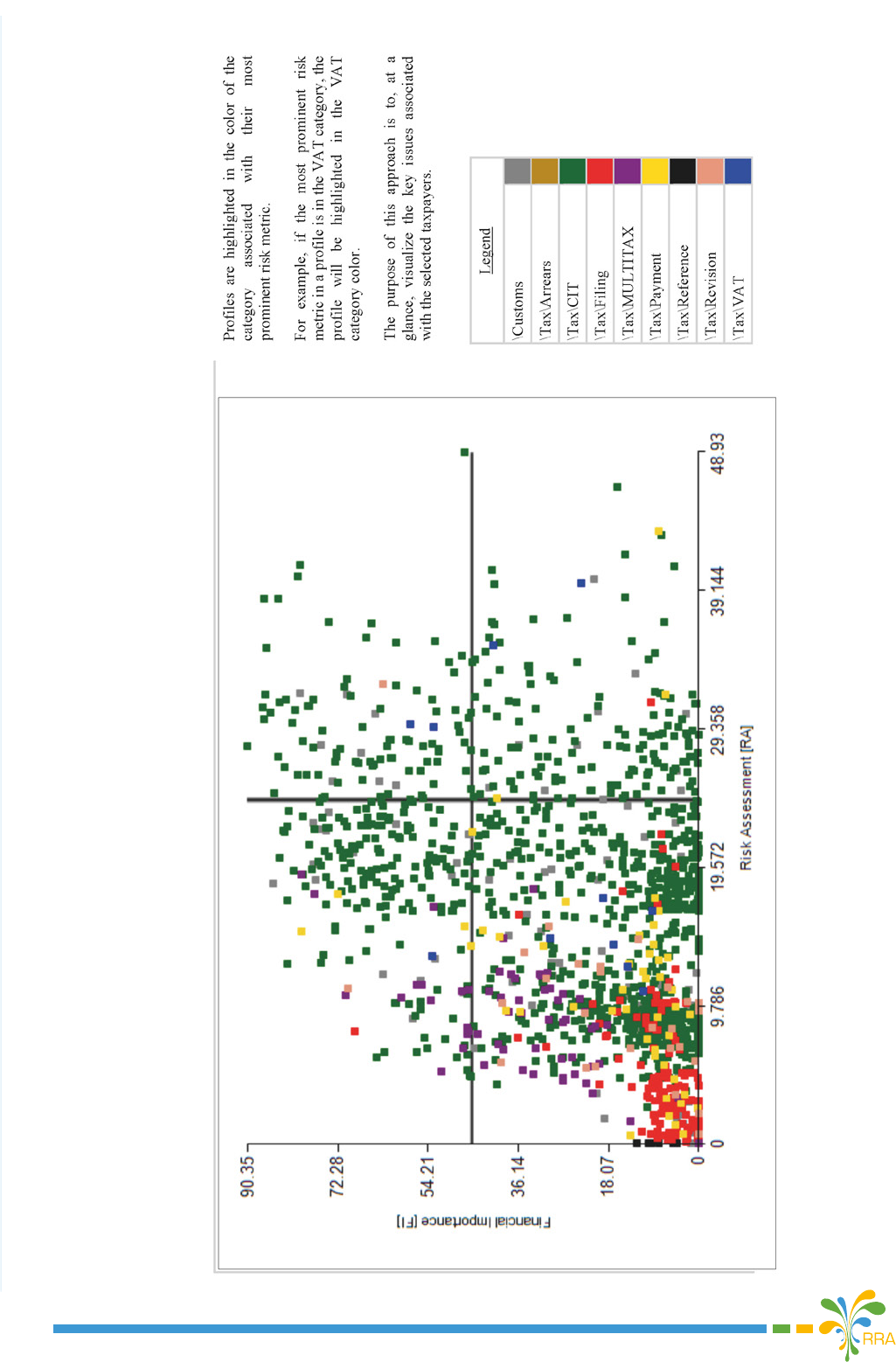
RDF Results for Construction
Risk Proles: Enterprises (Sector, Point-Score Base
Compliance Improvement Plan
12

Compliance Improvement Plan
13
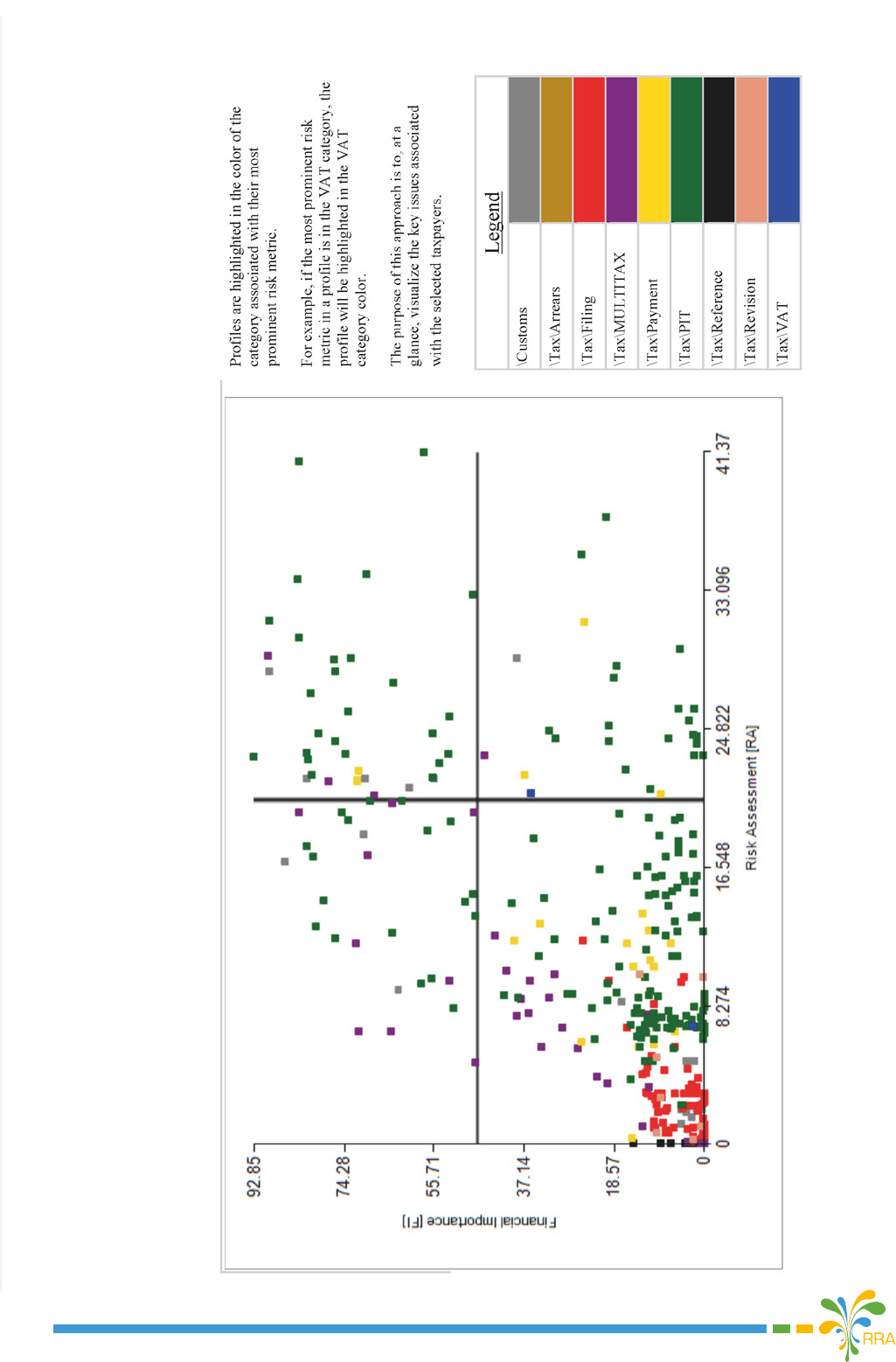
RDF Results for Construction
Risk Proles: Individuals (Sector, Point-Score Basis)
Compliance Improvement Plan
14
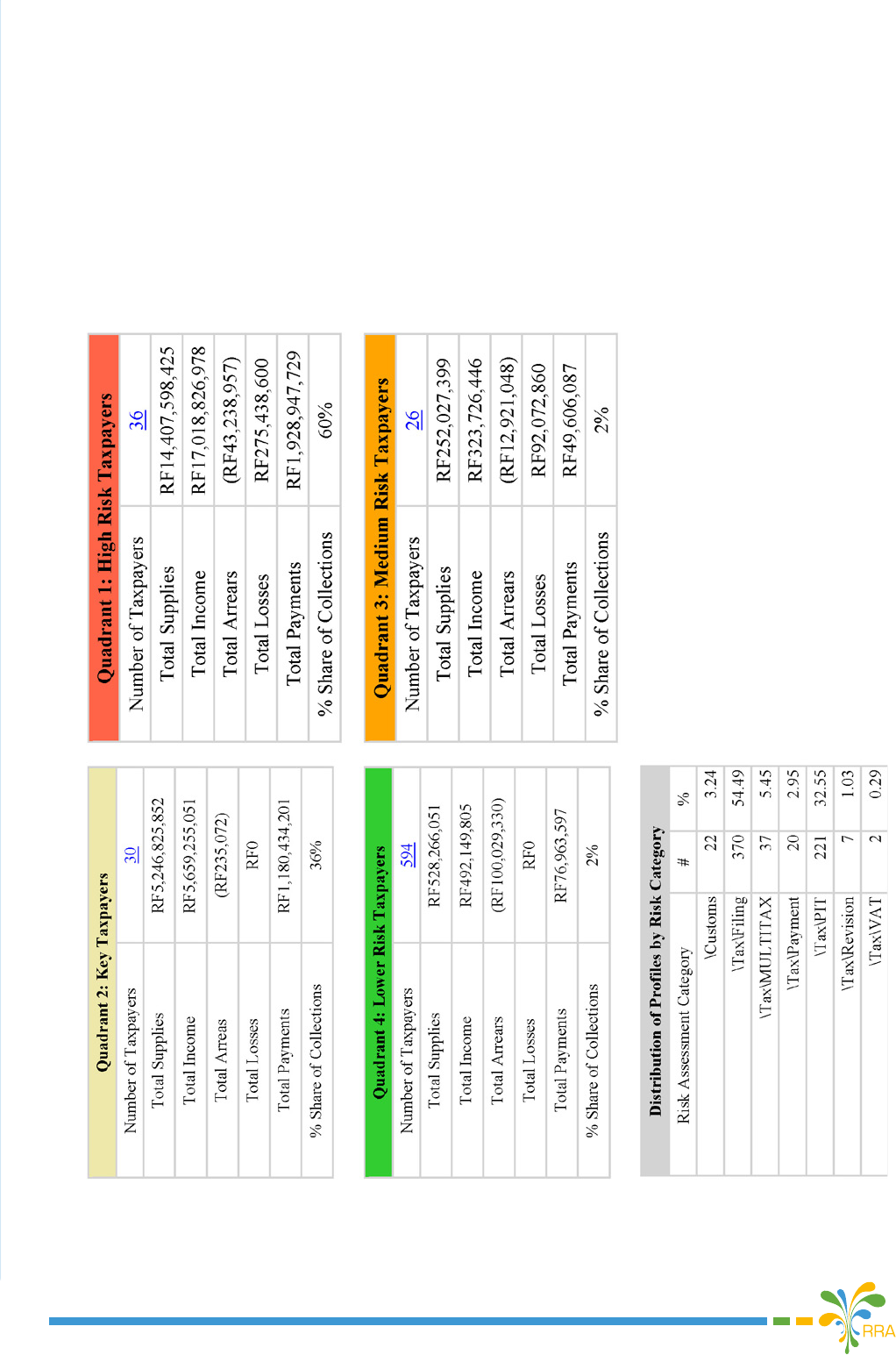
Compliance Improvement Plan
15
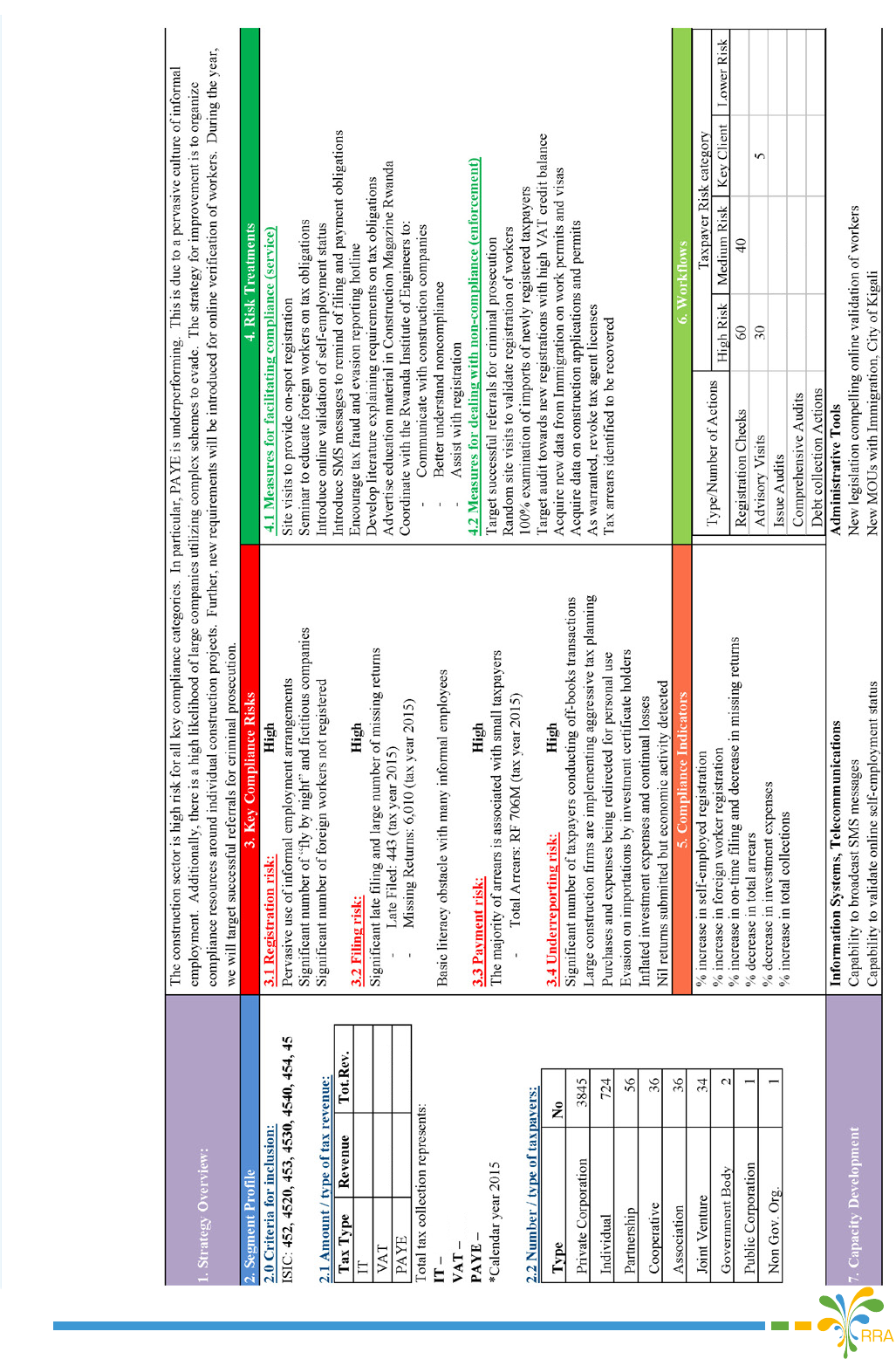
2.2.1. Compliance Strategy: Construction
Compliance Improvement Plan
16
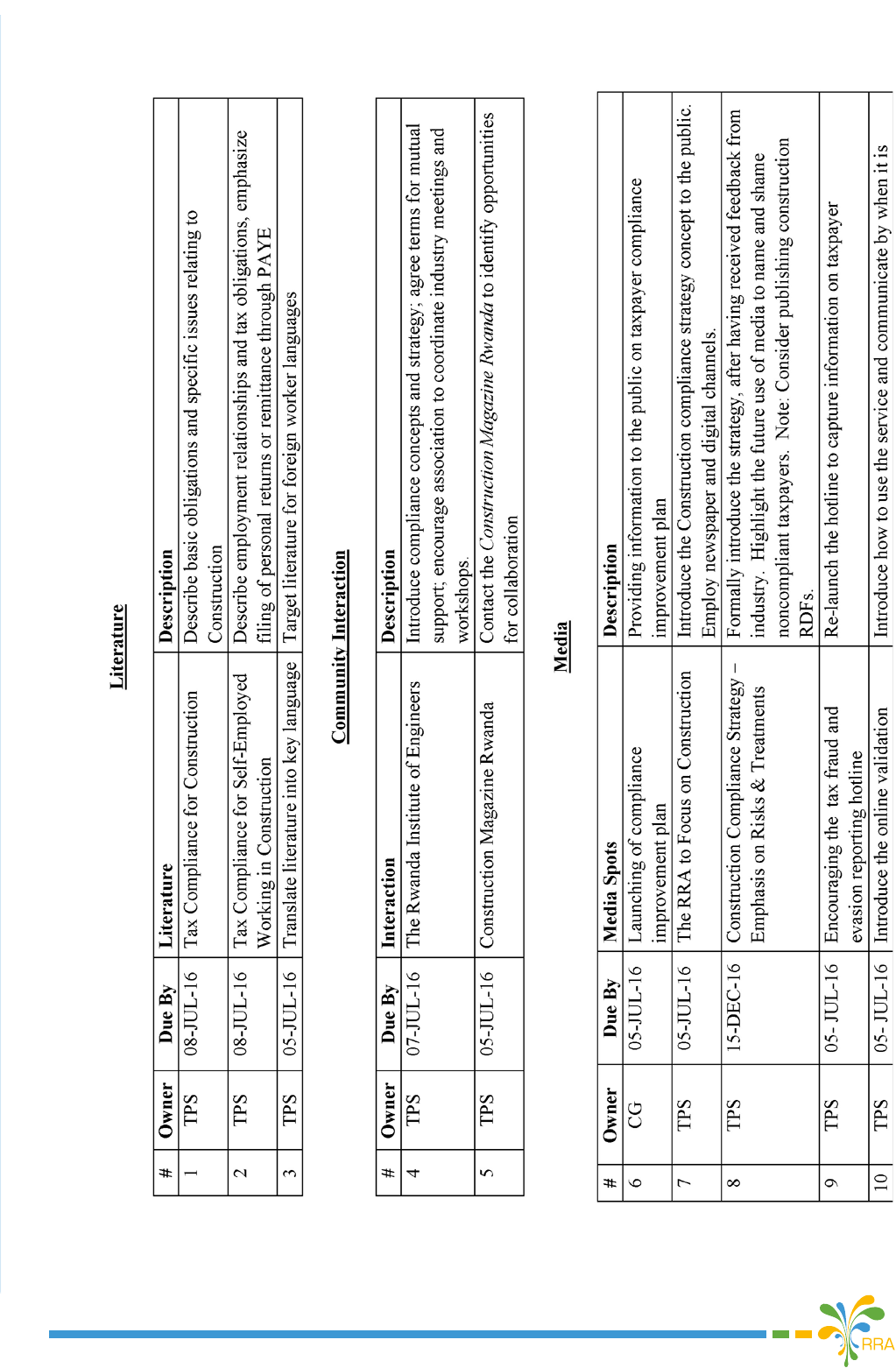
2.2.2. Compliance Strategy Action Plan: Construction
Compliance Improvement Plan
17
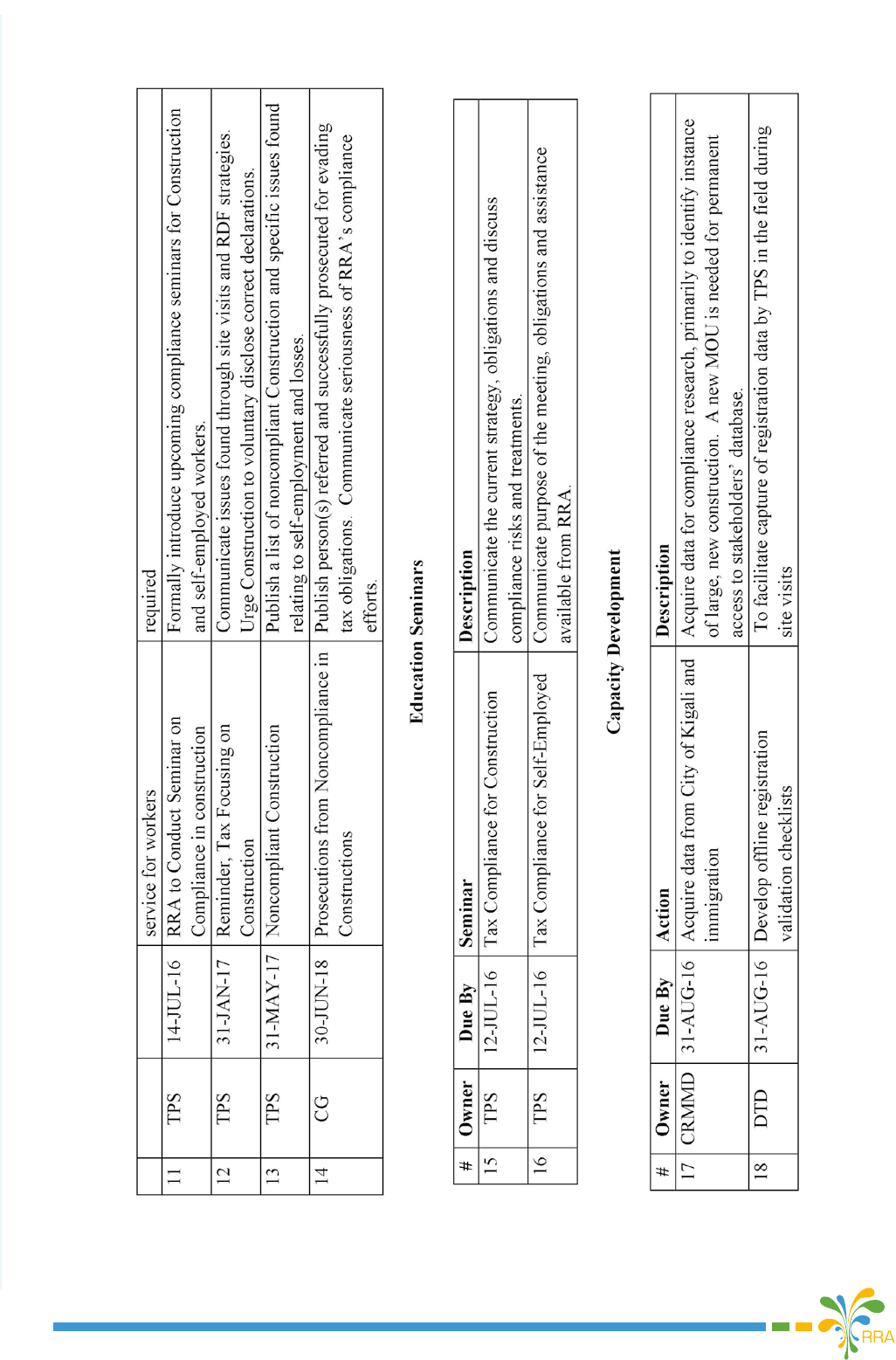
2.2.2. Compliance Strategy Action Plan: Construction [Continued]
Compliance Improvement Plan
18
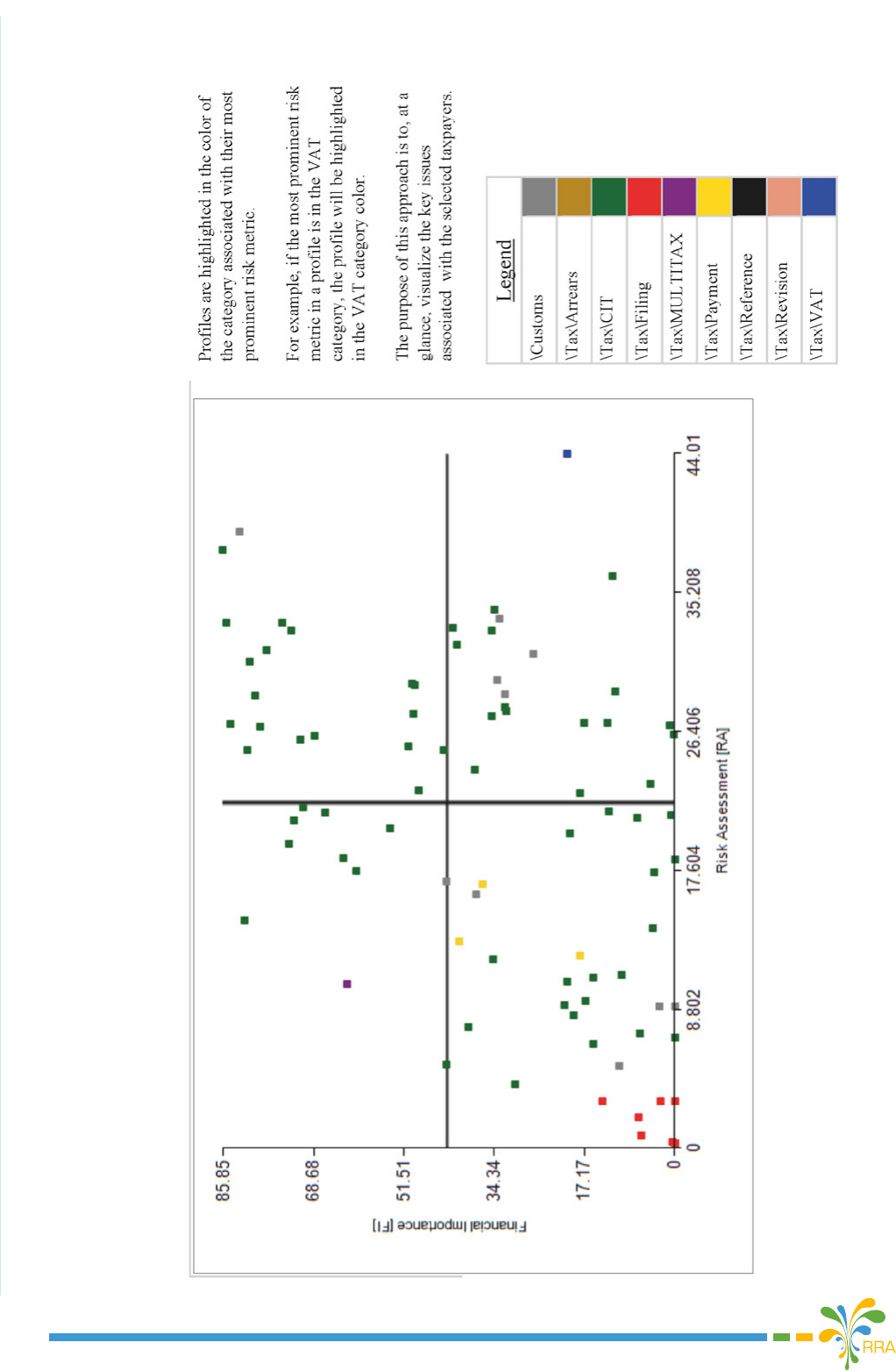
RDF Results for Hotels
Risk Proles: Enterprises (Sector, Point-Score Basis)
Compliance Improvement Plan
19
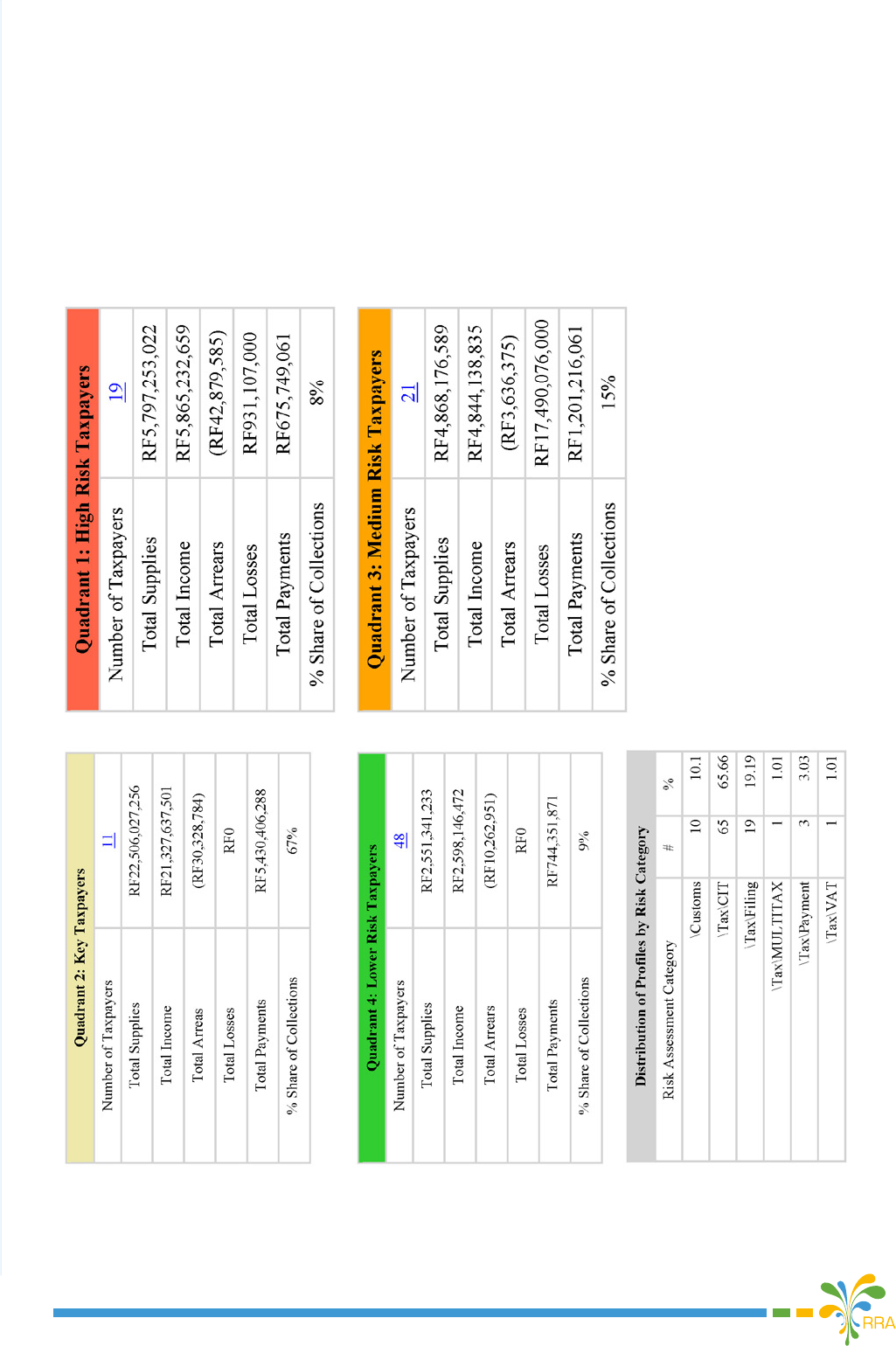
Compliance Improvement Plan
20
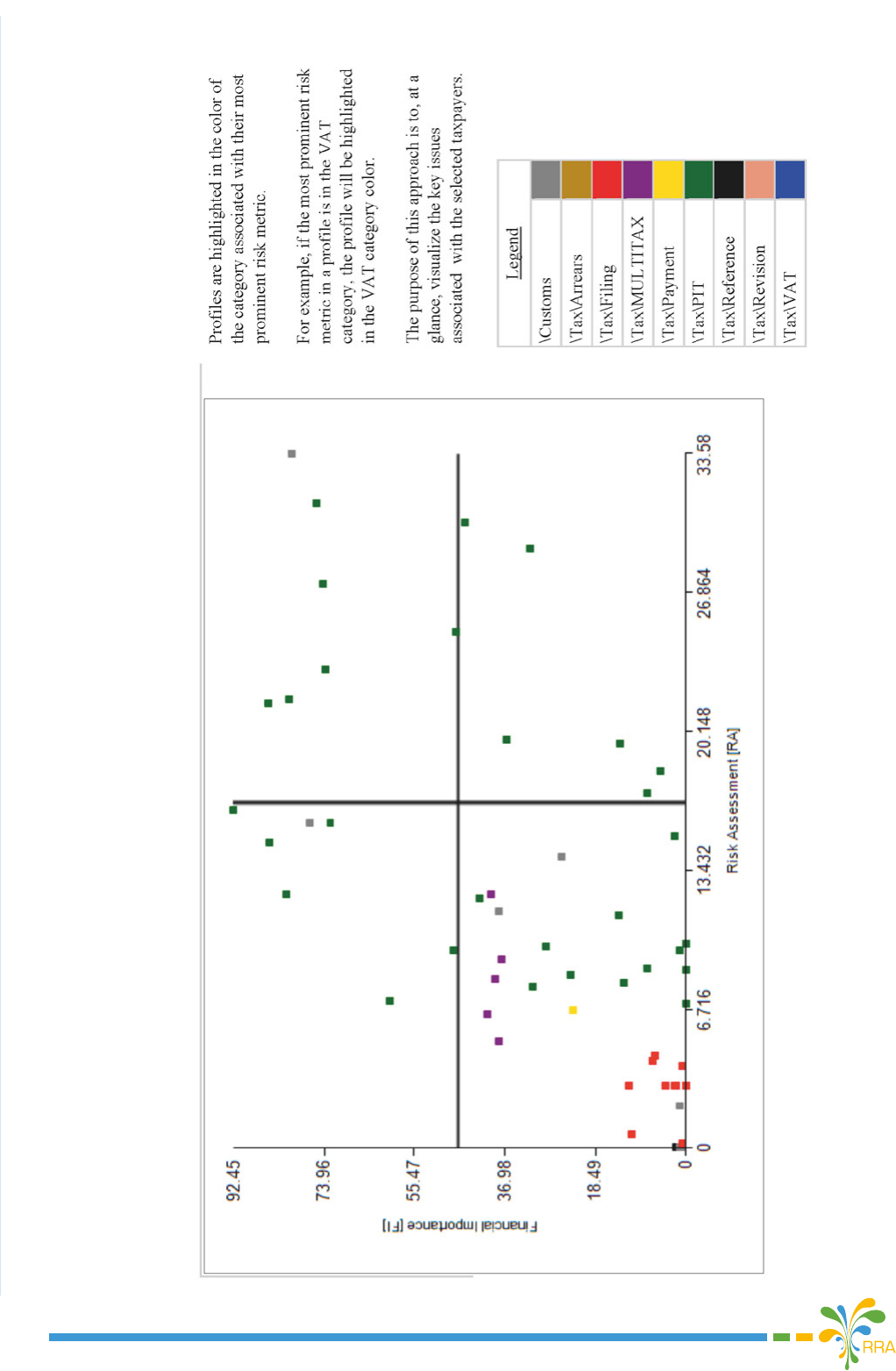
RDF Results for Hotels
Risk Proles: Individuals (Sector, Point-Score Basis)
Compliance Improvement Plan
21
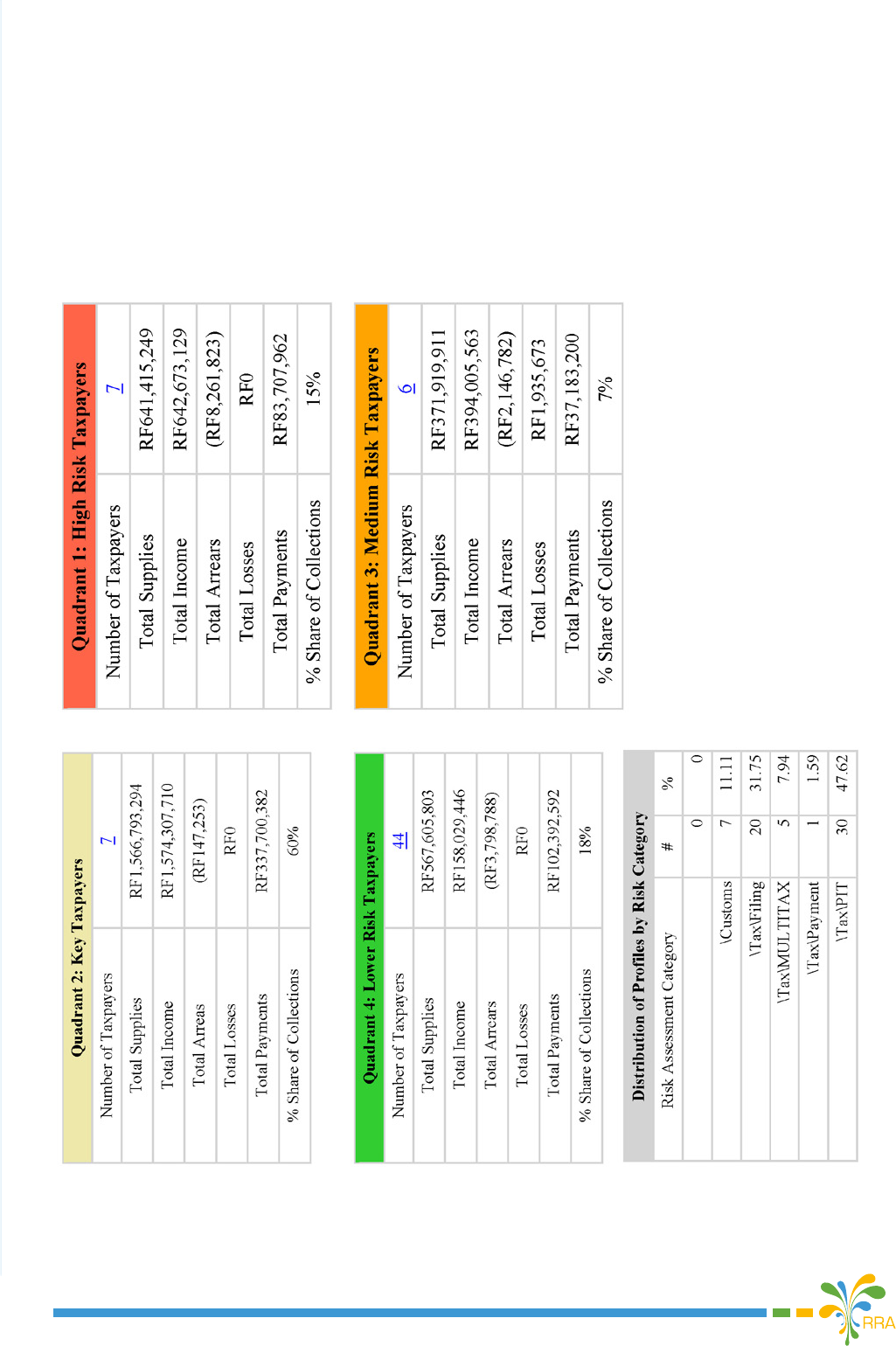
Compliance Improvement Plan
22
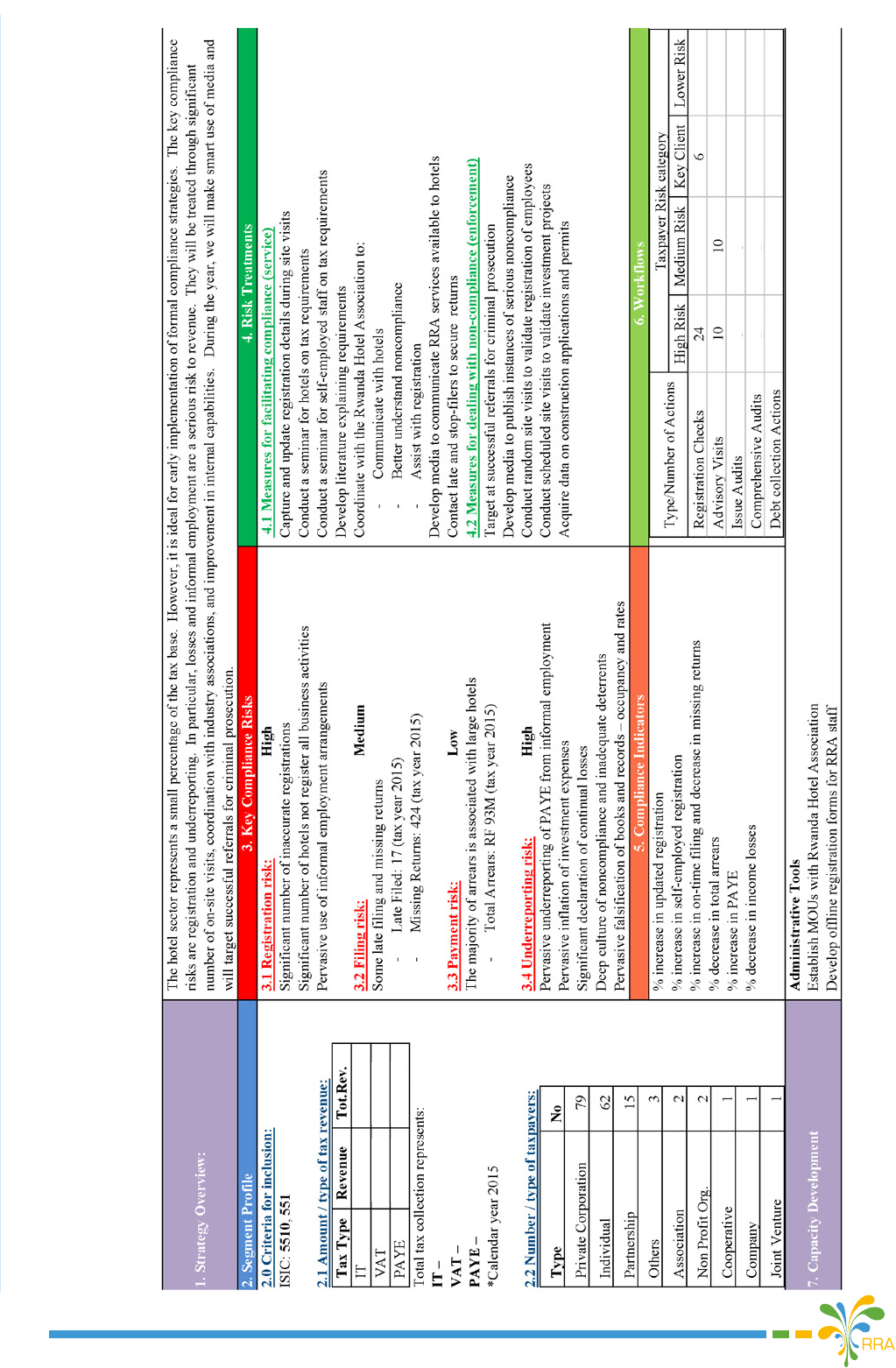
2.2.3. Compliance Strategy: Hotels
Compliance Improvement Plan
23
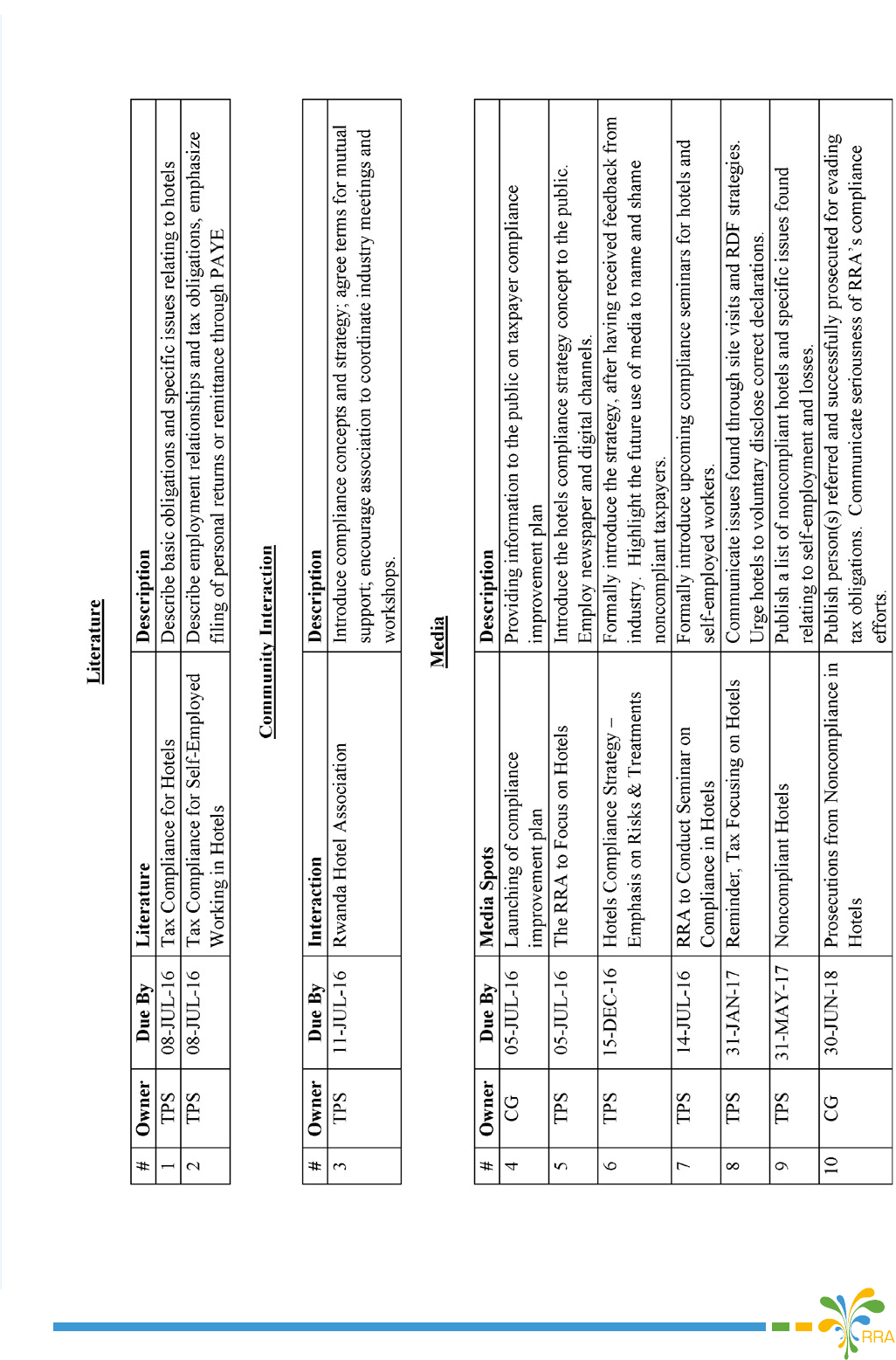
2.2.4. Compliance Strategy Action Plan: Hotels
Compliance Improvement Plan
Note: Consider publishing hotel RDFs.
24
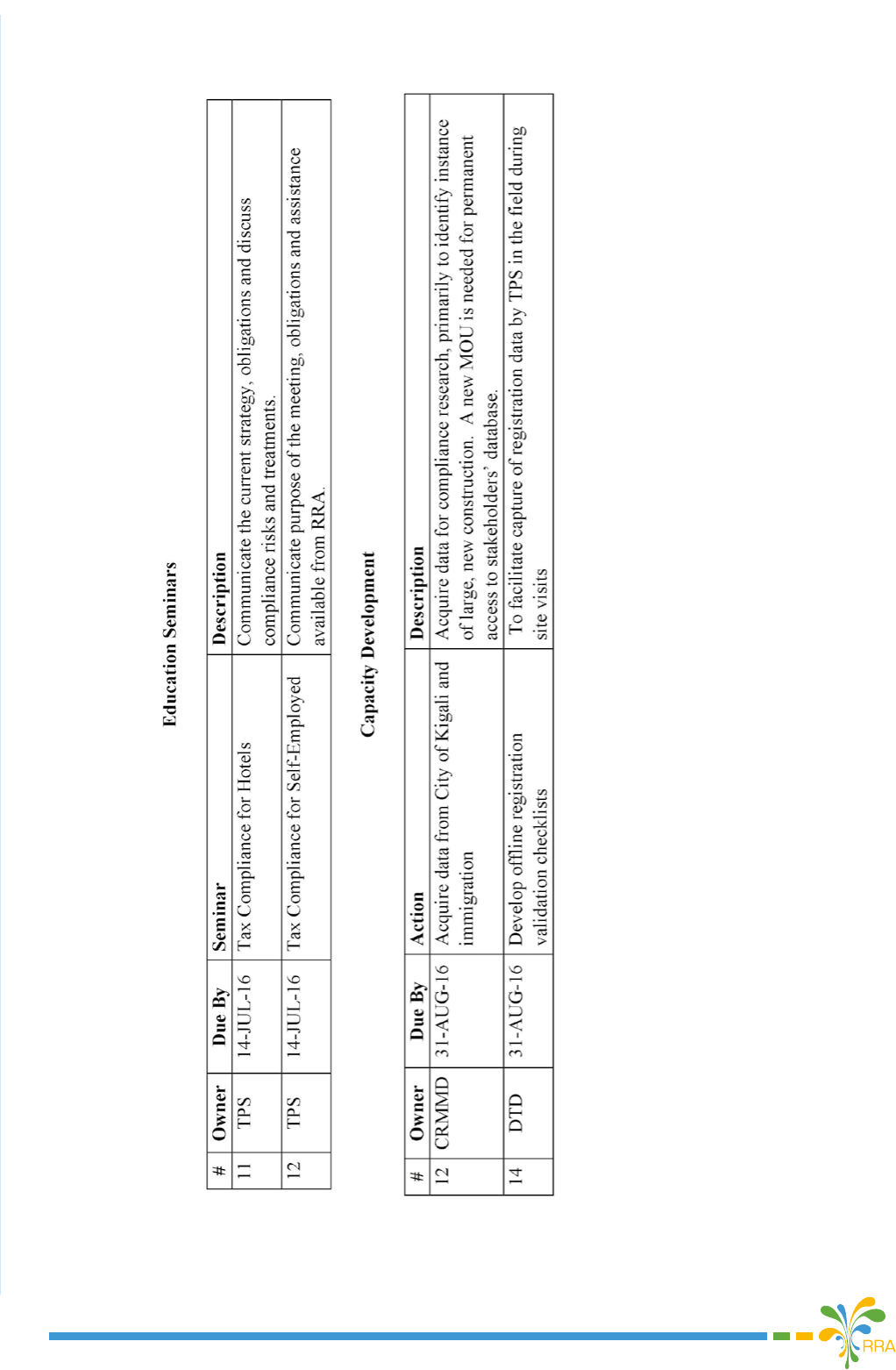
2.2.4. Compliance Strategy Action Plan: Hotels [Continued]
Compliance Improvement Plan
25
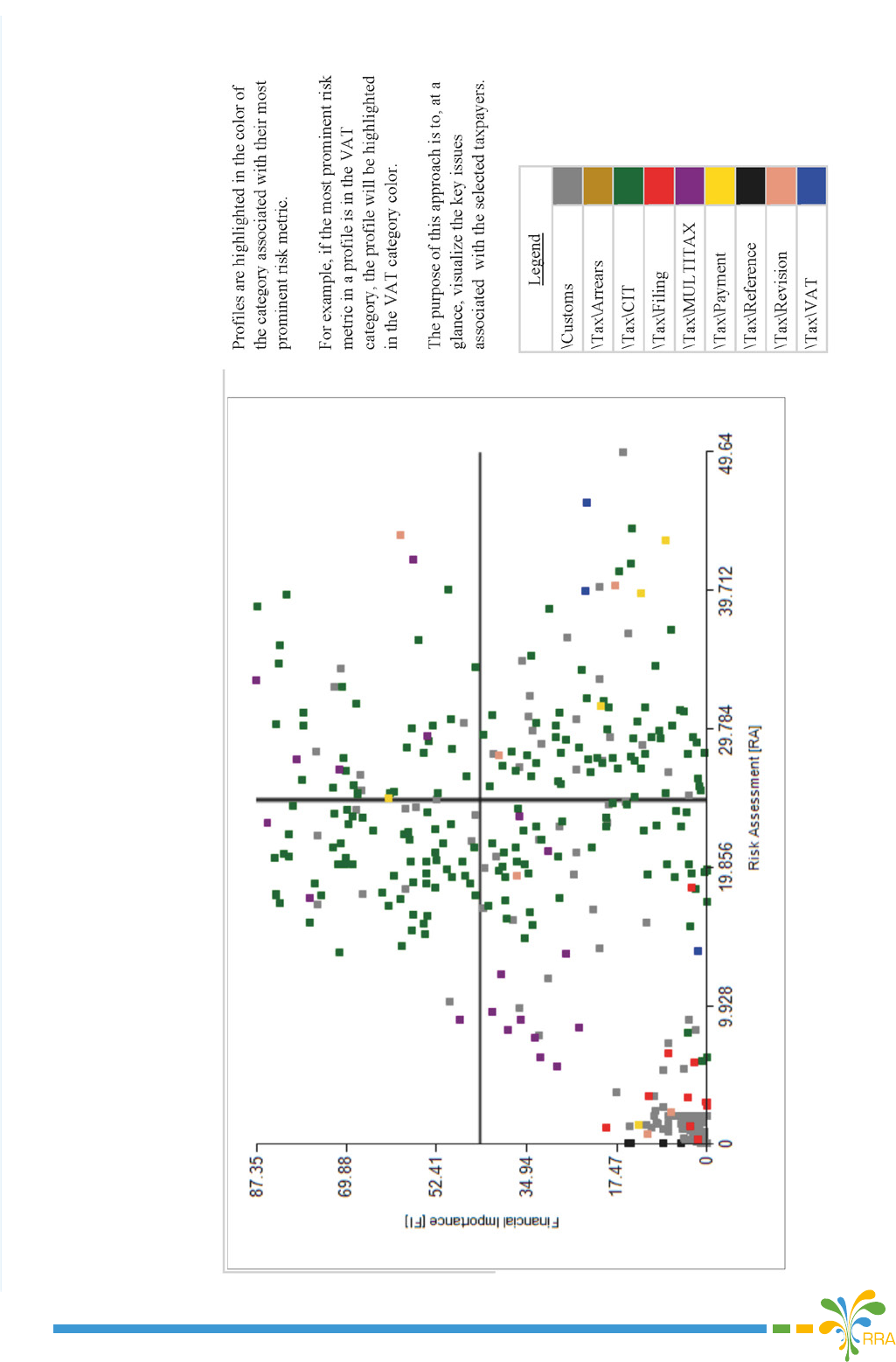
RDF Results for Large Taxpayers
Risk Proles: Enterprises (Cross-Sector, Point-Score Basis)
Compliance Improvement Plan
26
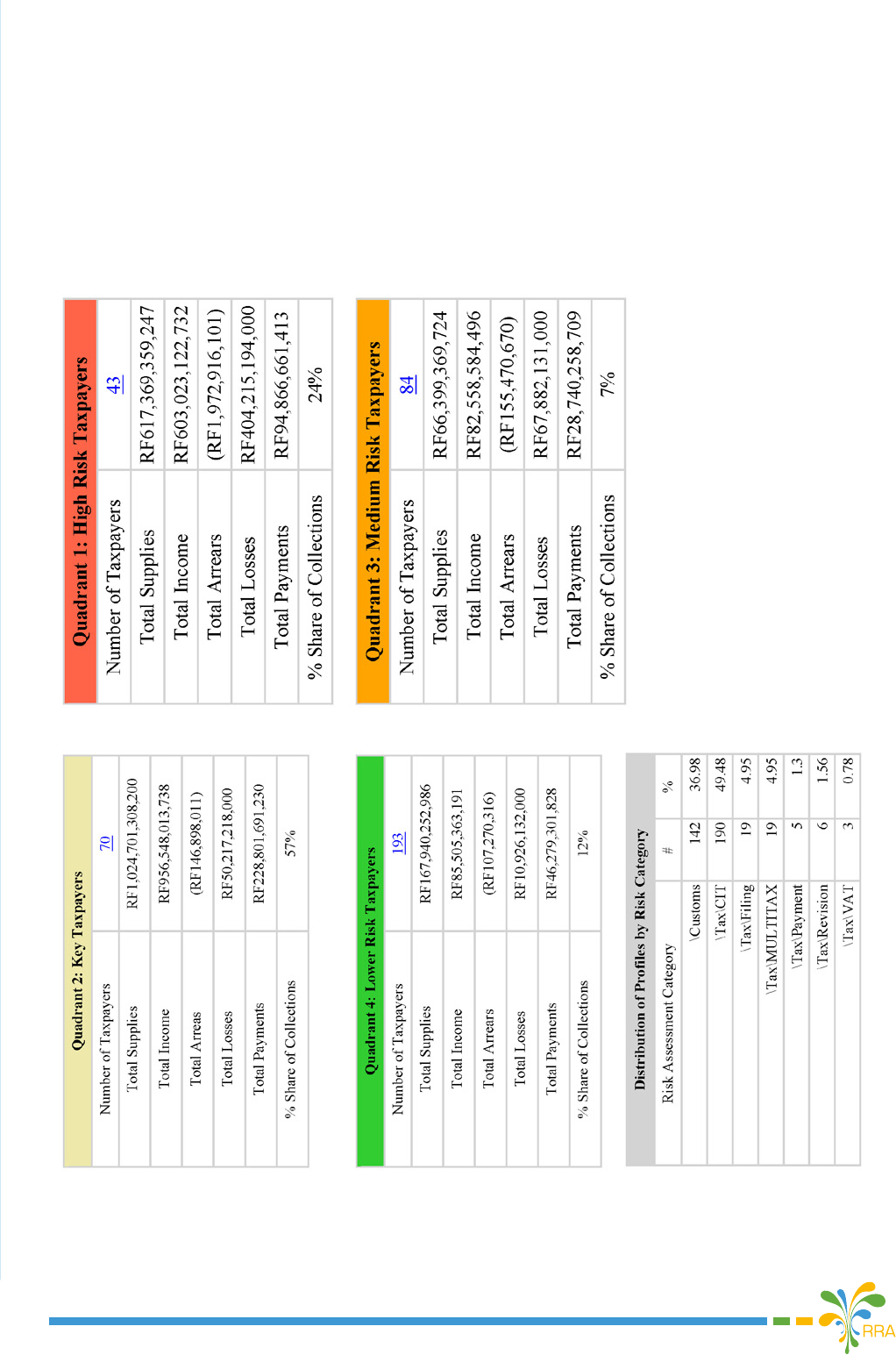
Compliance Improvement Plan
27
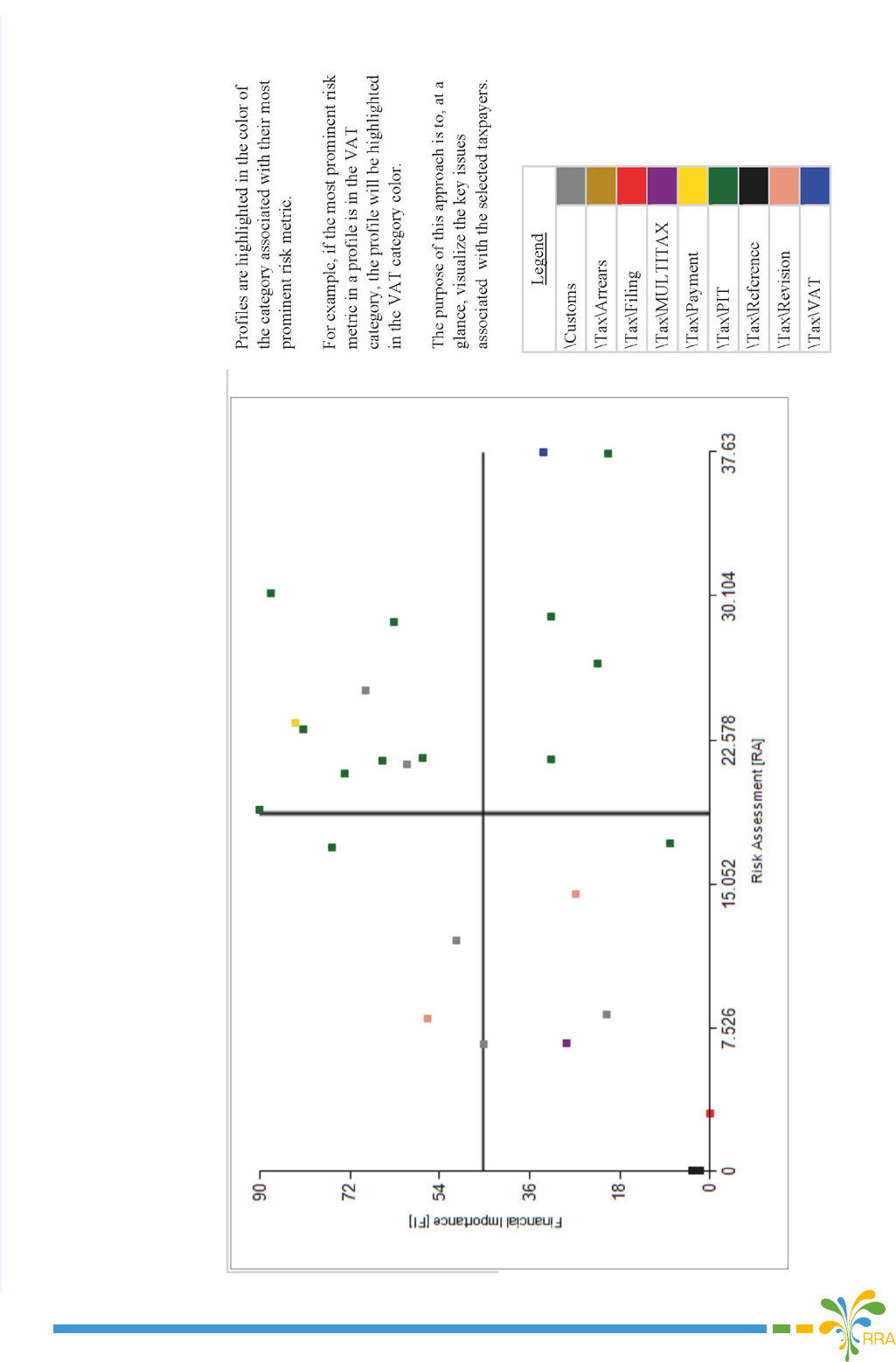
RDF Results for Large Taxpayers
Risk Proles: Individuals (Cross-Sector, Point-Score Basis)
Compliance Improvement Plan
28
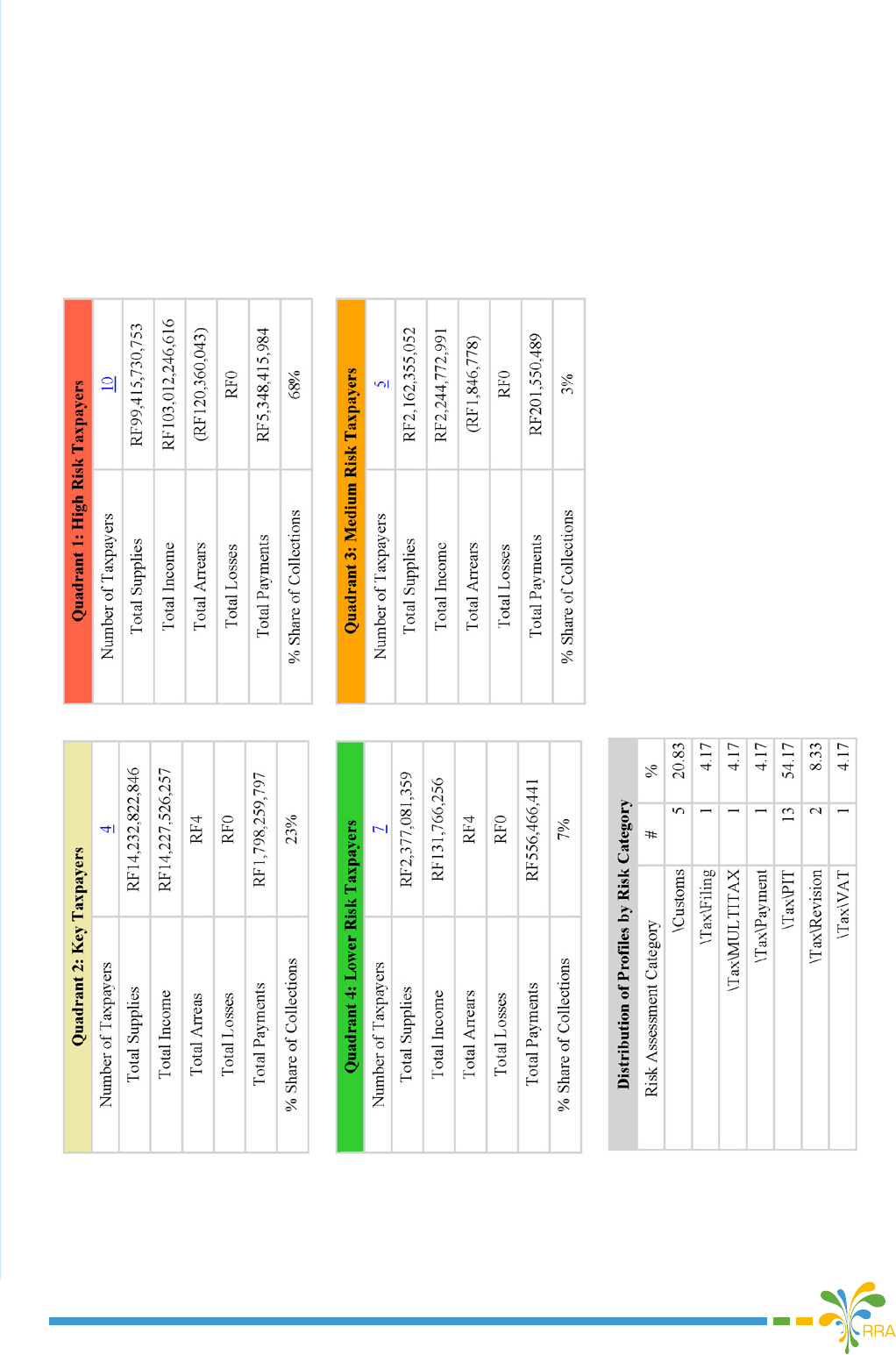
Compliance Improvement Plan
29
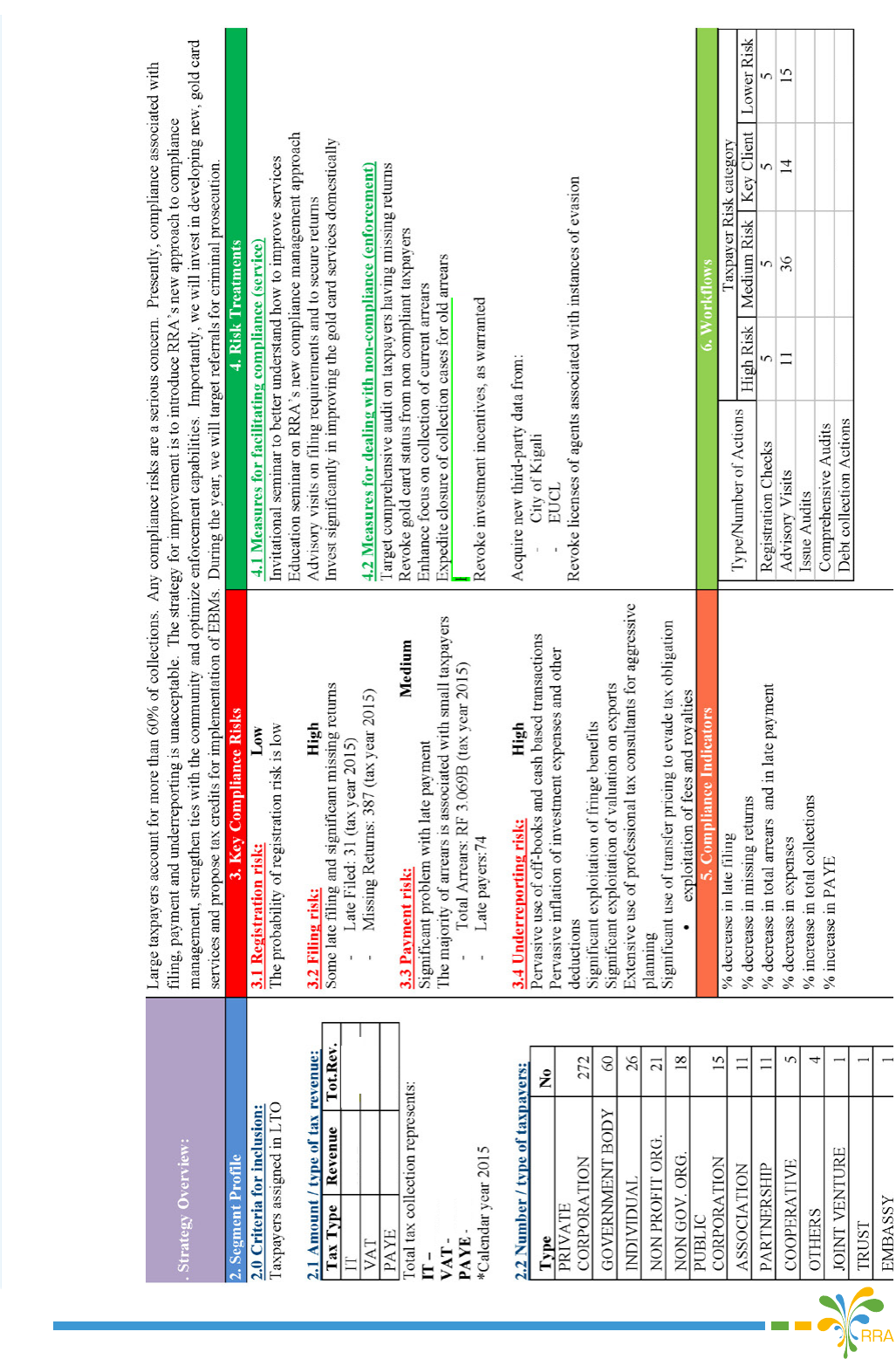
2.2.5. Compliance Strategy: Large Taxpayers
Compliance Improvement Plan
54.9B
Focus issue audits on investments and loses
30
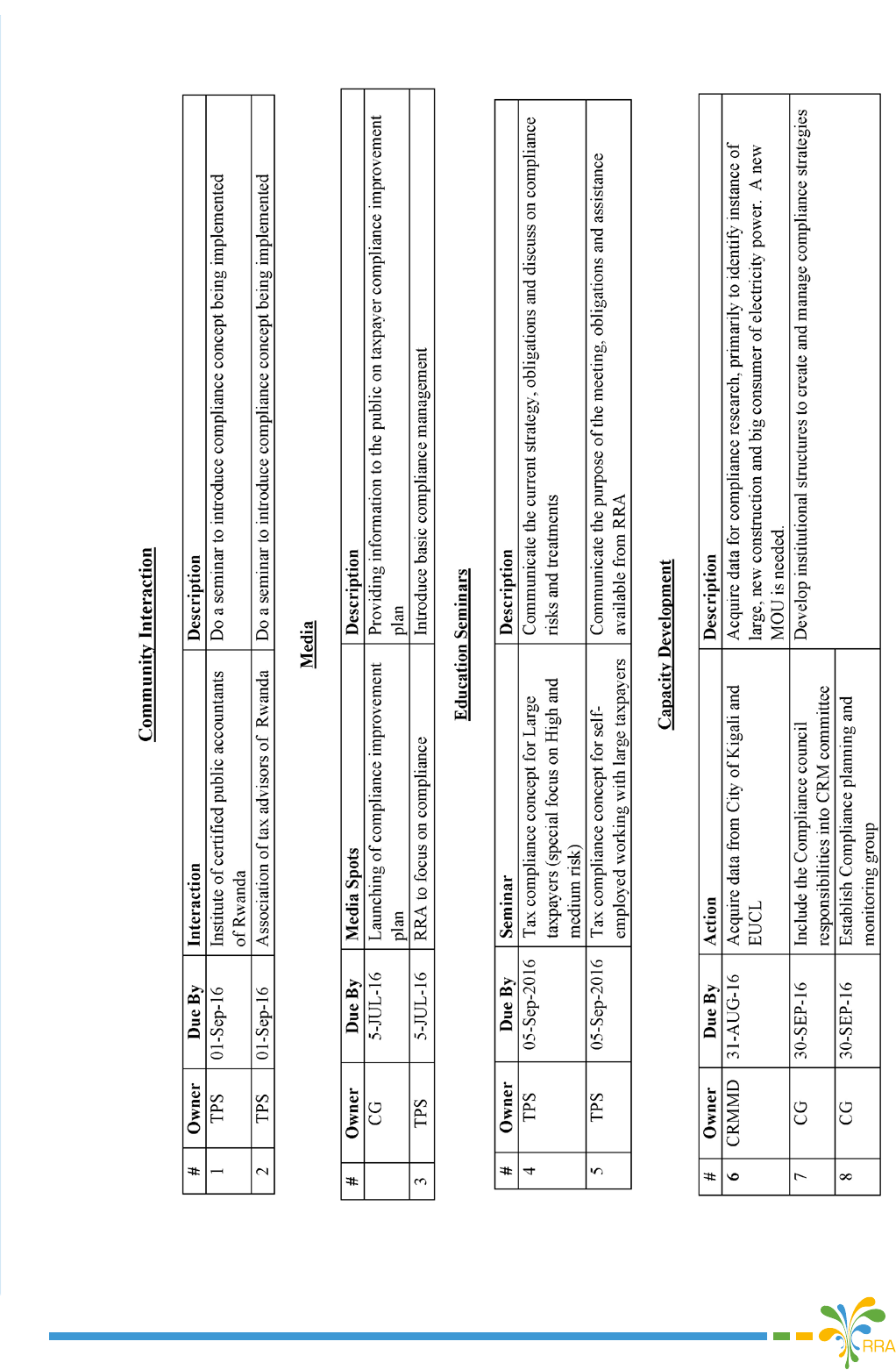
2.2.6. Compliance Strategy Action Plan: LTO
Compliance Improvement Plan
31
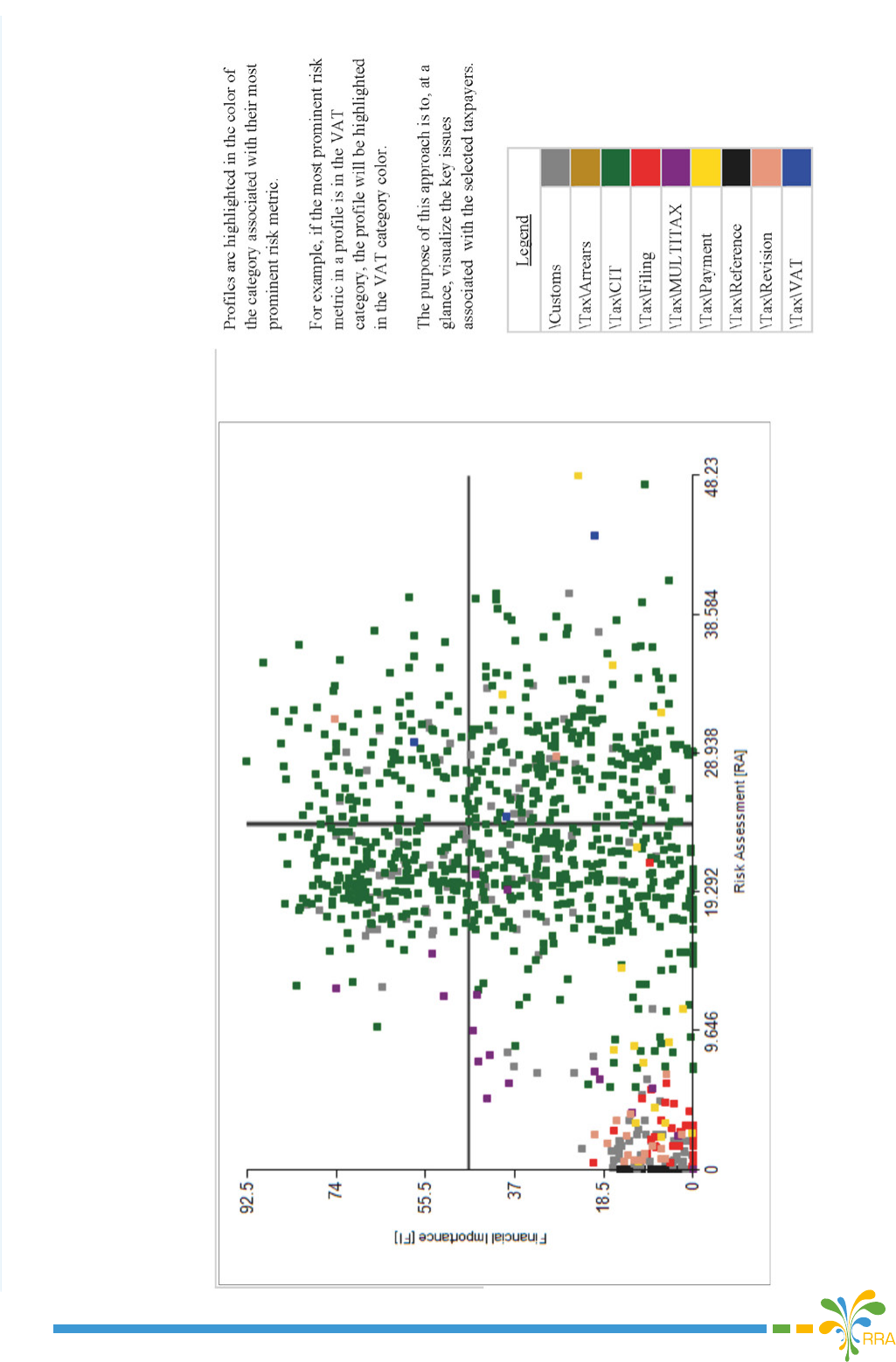
RDF Results for Medium Taxpayers
Risk Proles: Enterprises (Cross-Sector, Point-Score Basis)
Compliance Improvement Plan
32
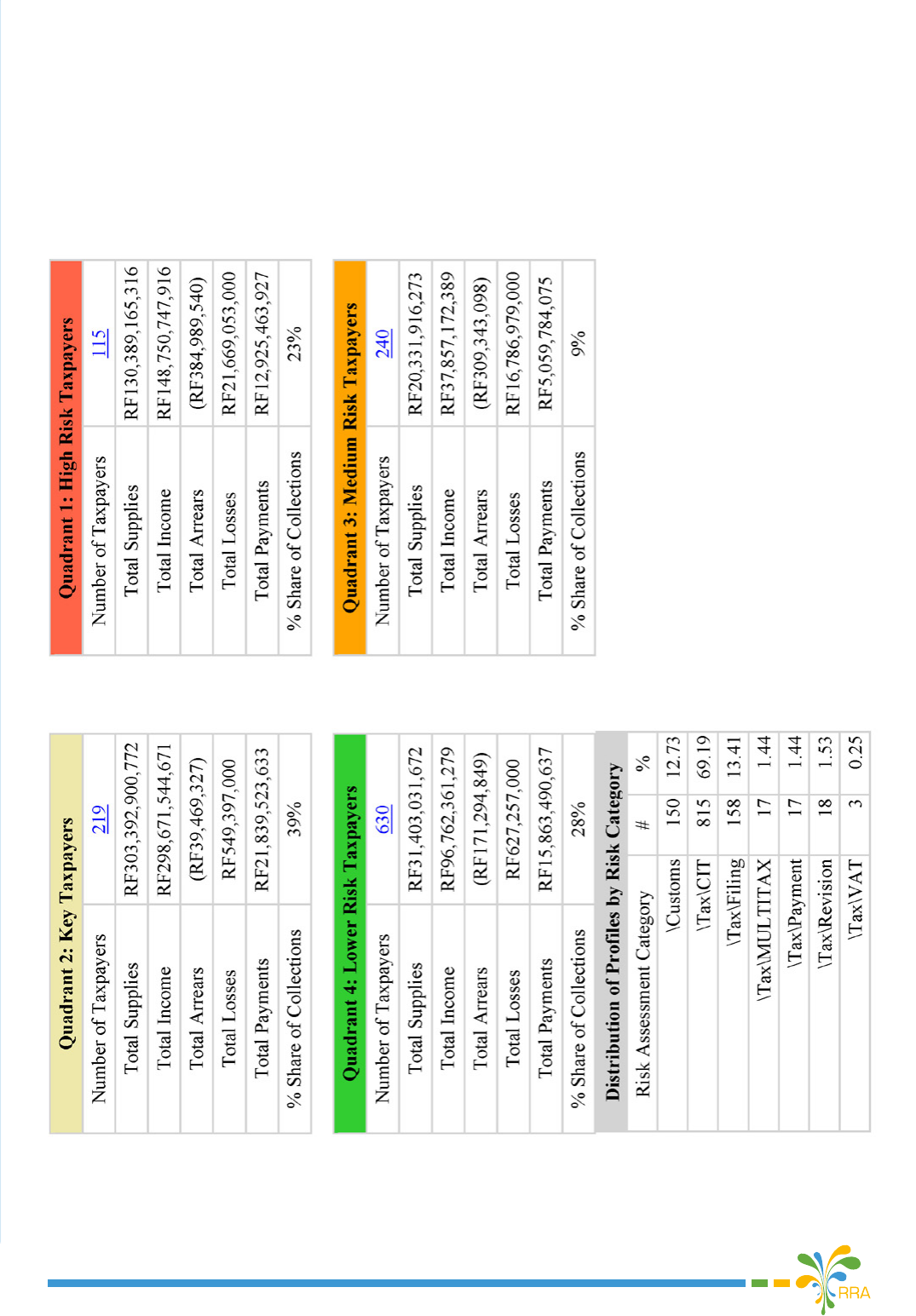
Compliance Improvement Plan
33
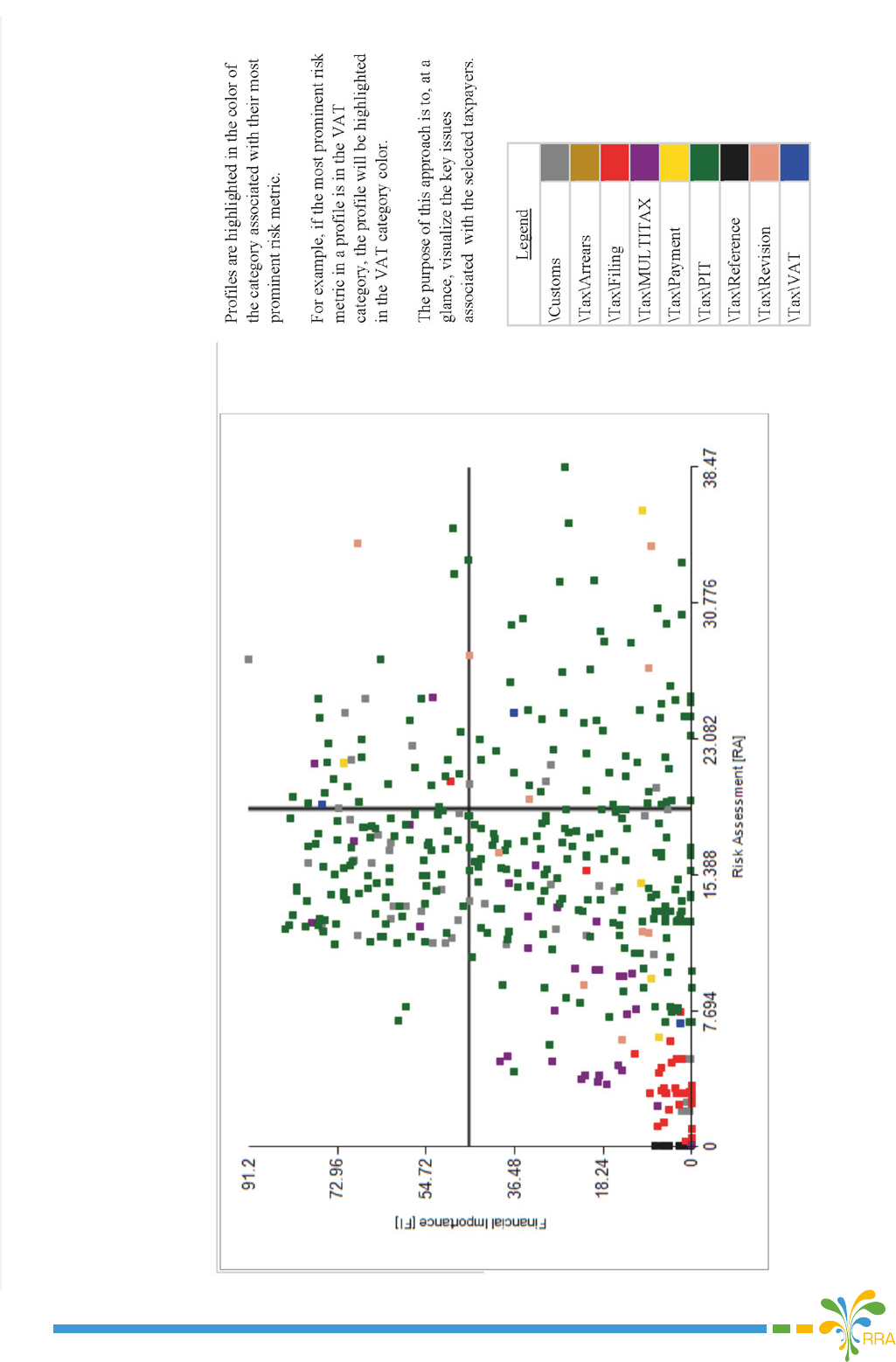
RDF Results for Medium Taxpayers
Risk Proles: Individuals (Cross-Sector, Point-Score Basis)
Compliance Improvement Plan
34
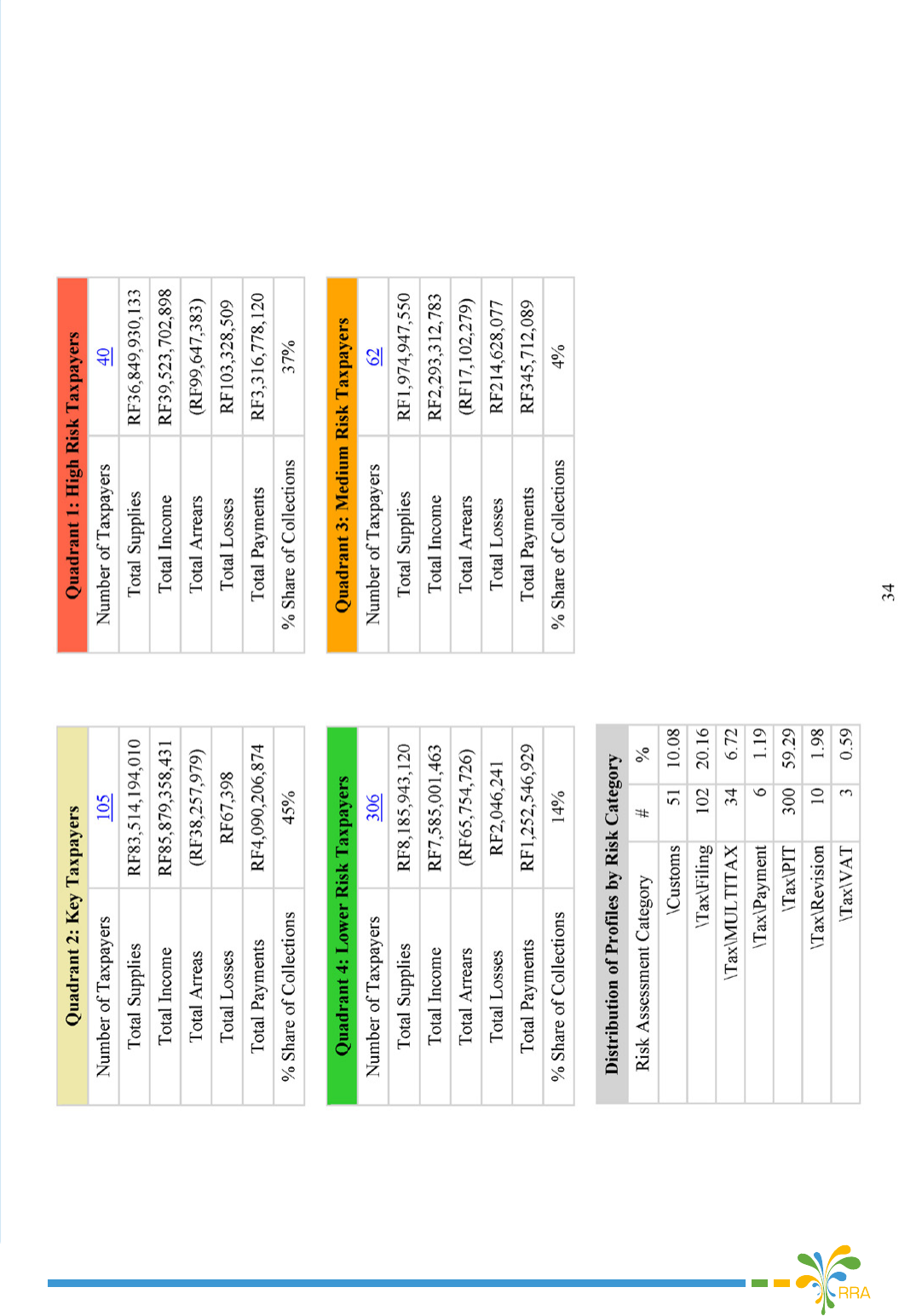
Compliance Improvement Plan
35
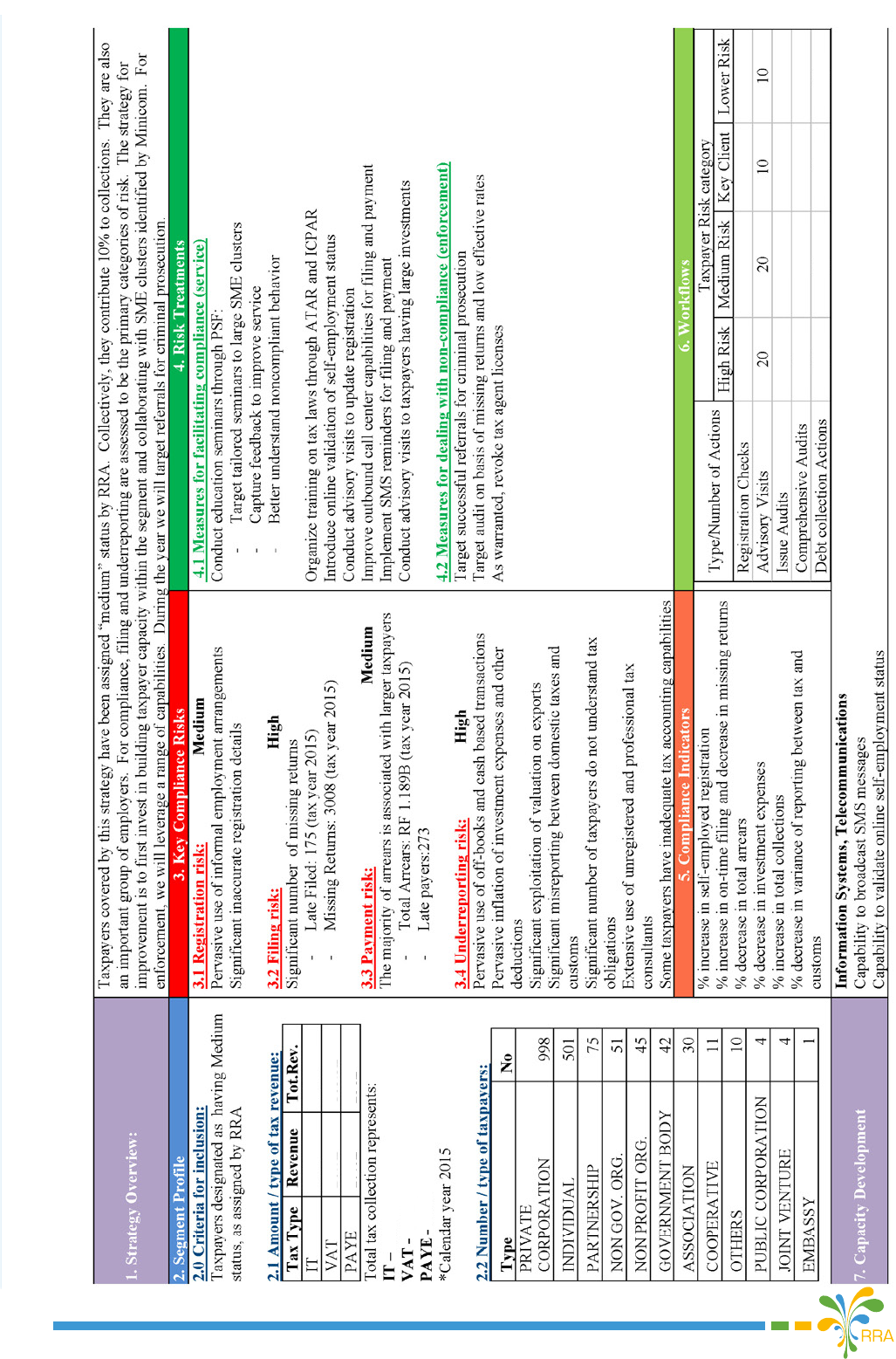
2.2.7. Compliance Strategy: Medium Taxpayers
Compliance Improvement Plan
36
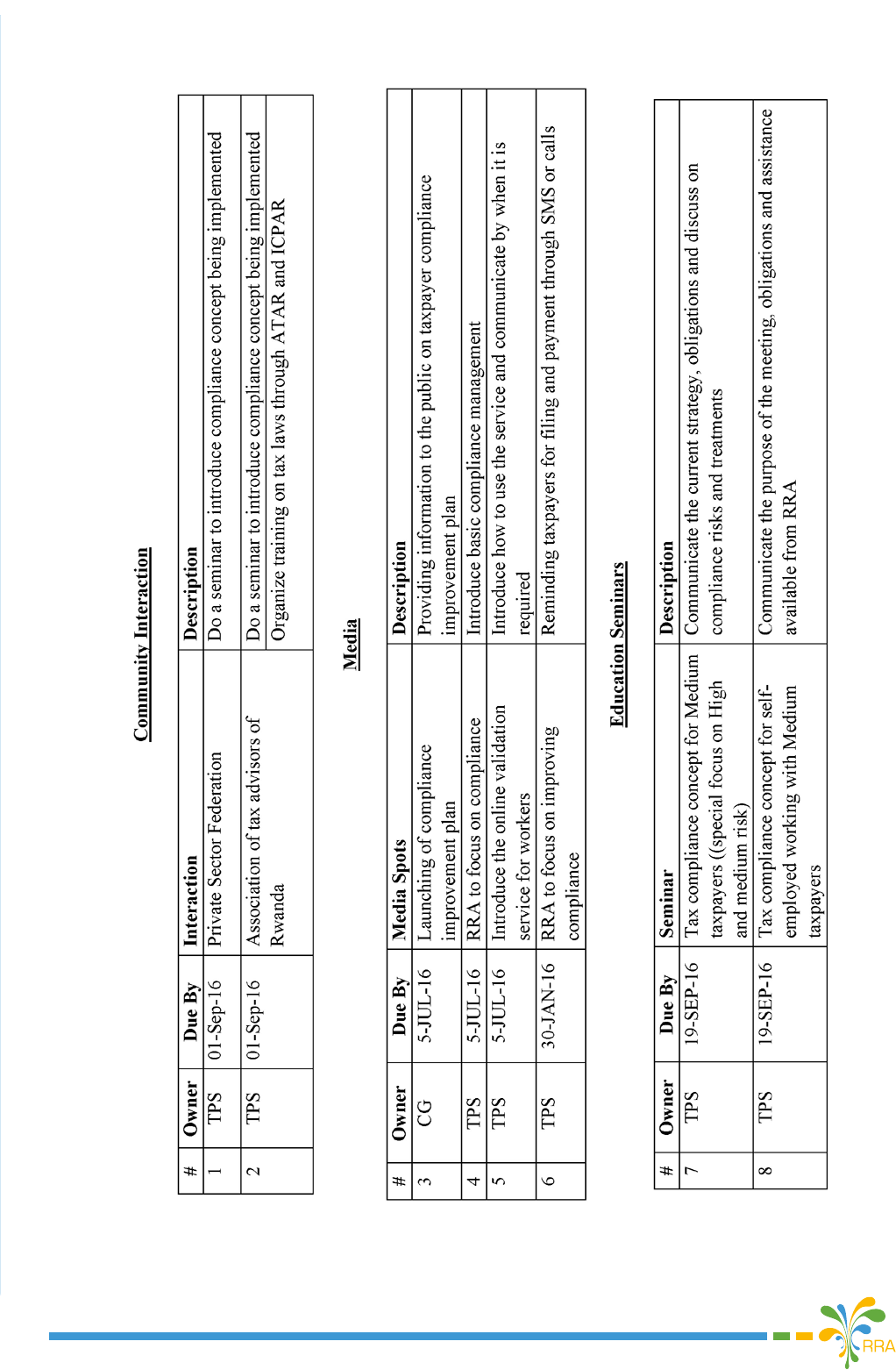
2.2.8. Compliance Strategy Action Plan: MEDIUM
Compliance Improvement Plan
37
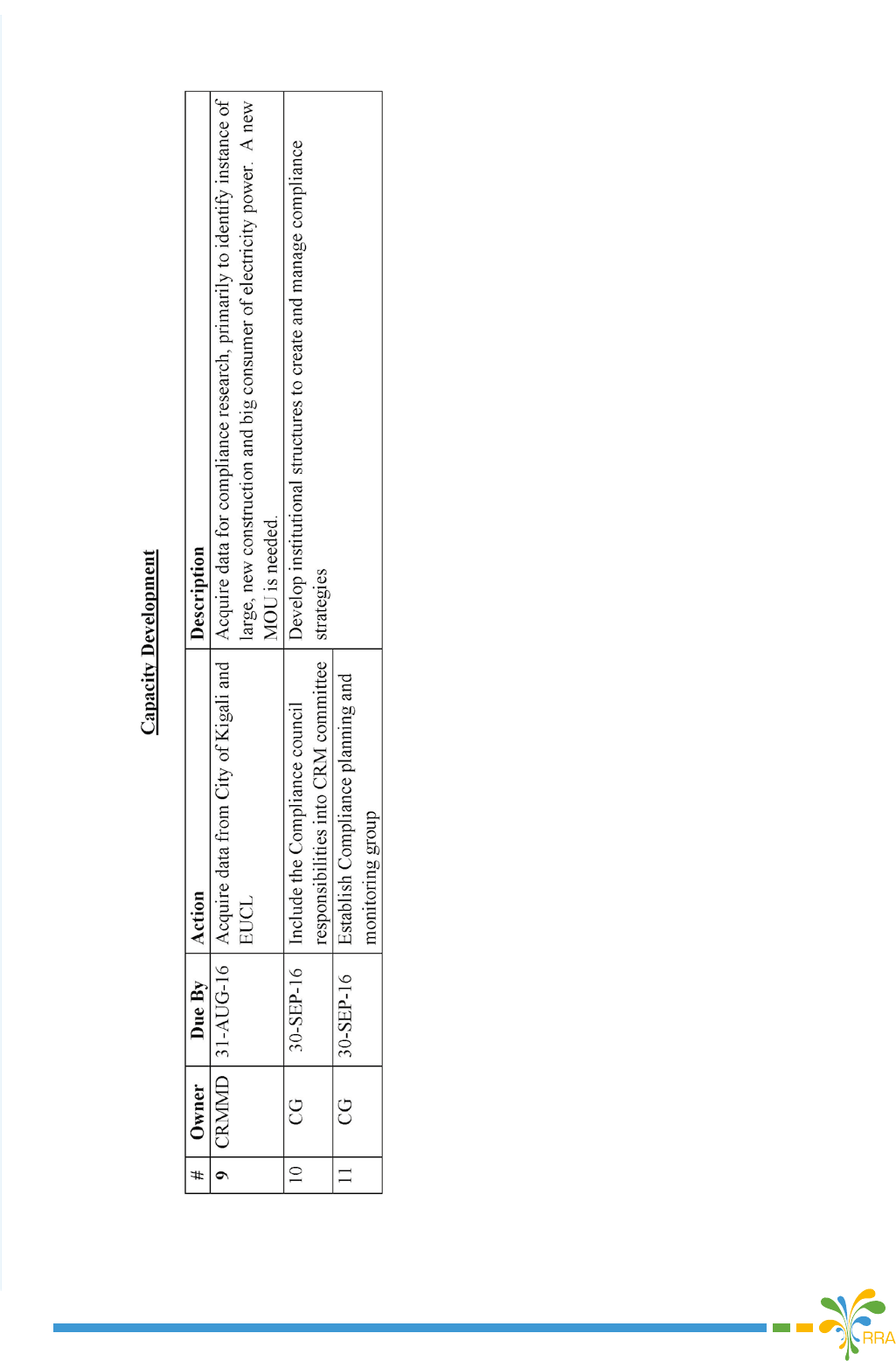
2.2.8. Compliance Strategy Action Plan: MEDIUM [Continued]
Compliance Improvement Plan
38
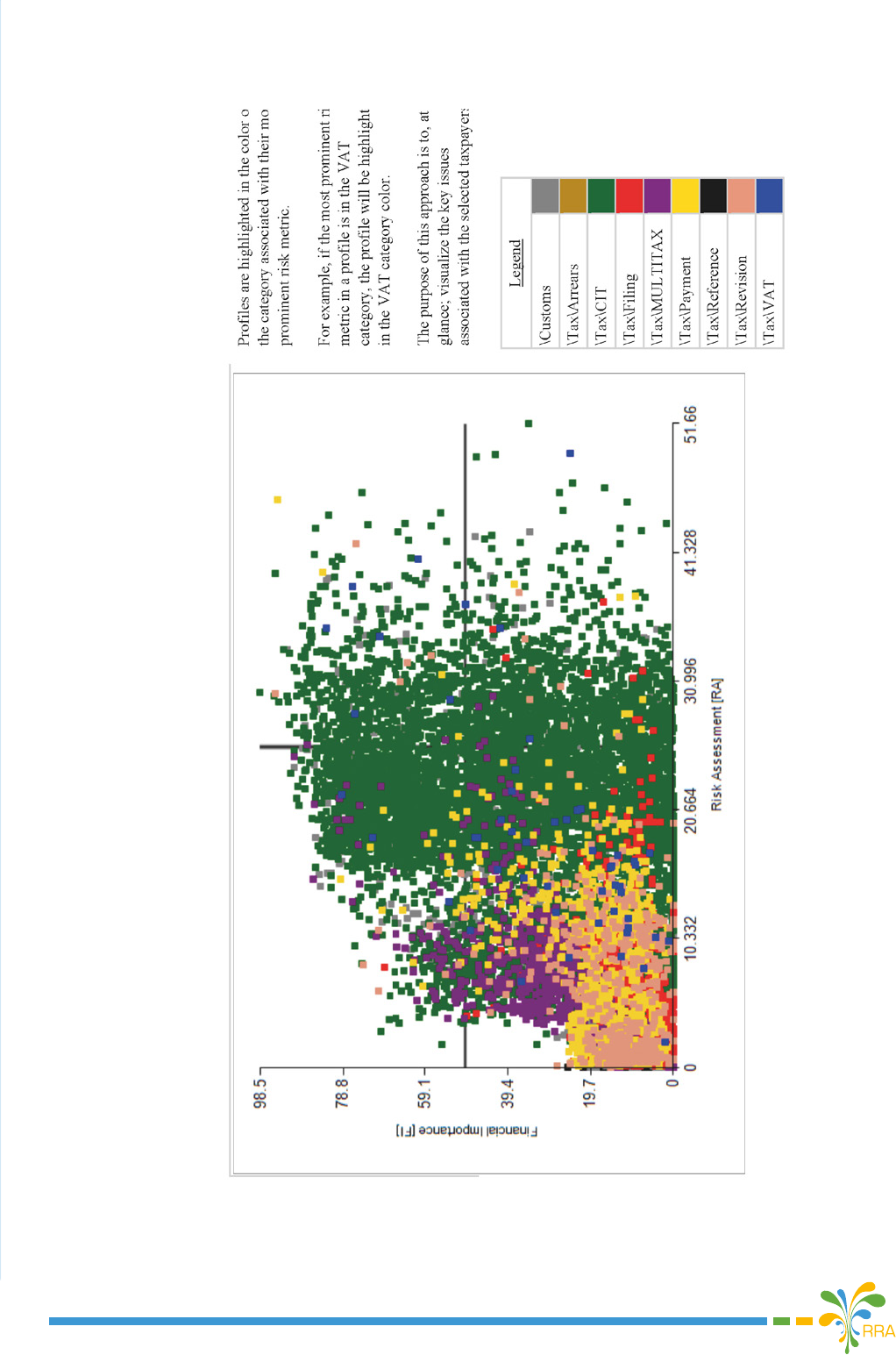
RDF Results for Small Taxpayers
Risk Proles: Enterprises (Cross-Sector, Point-Score Basis)
Compliance Improvement Plan
39
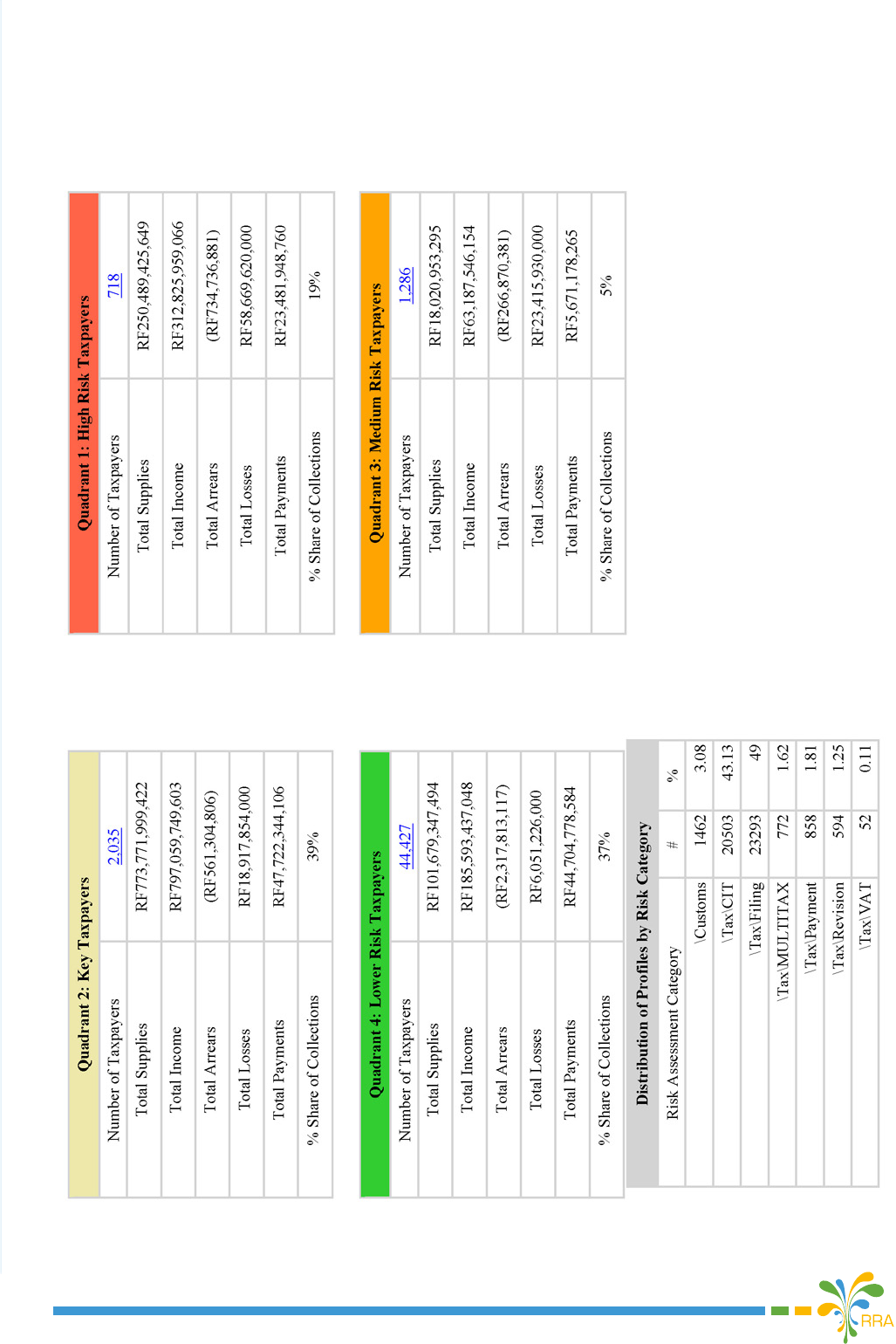
Compliance Improvement Plan
40
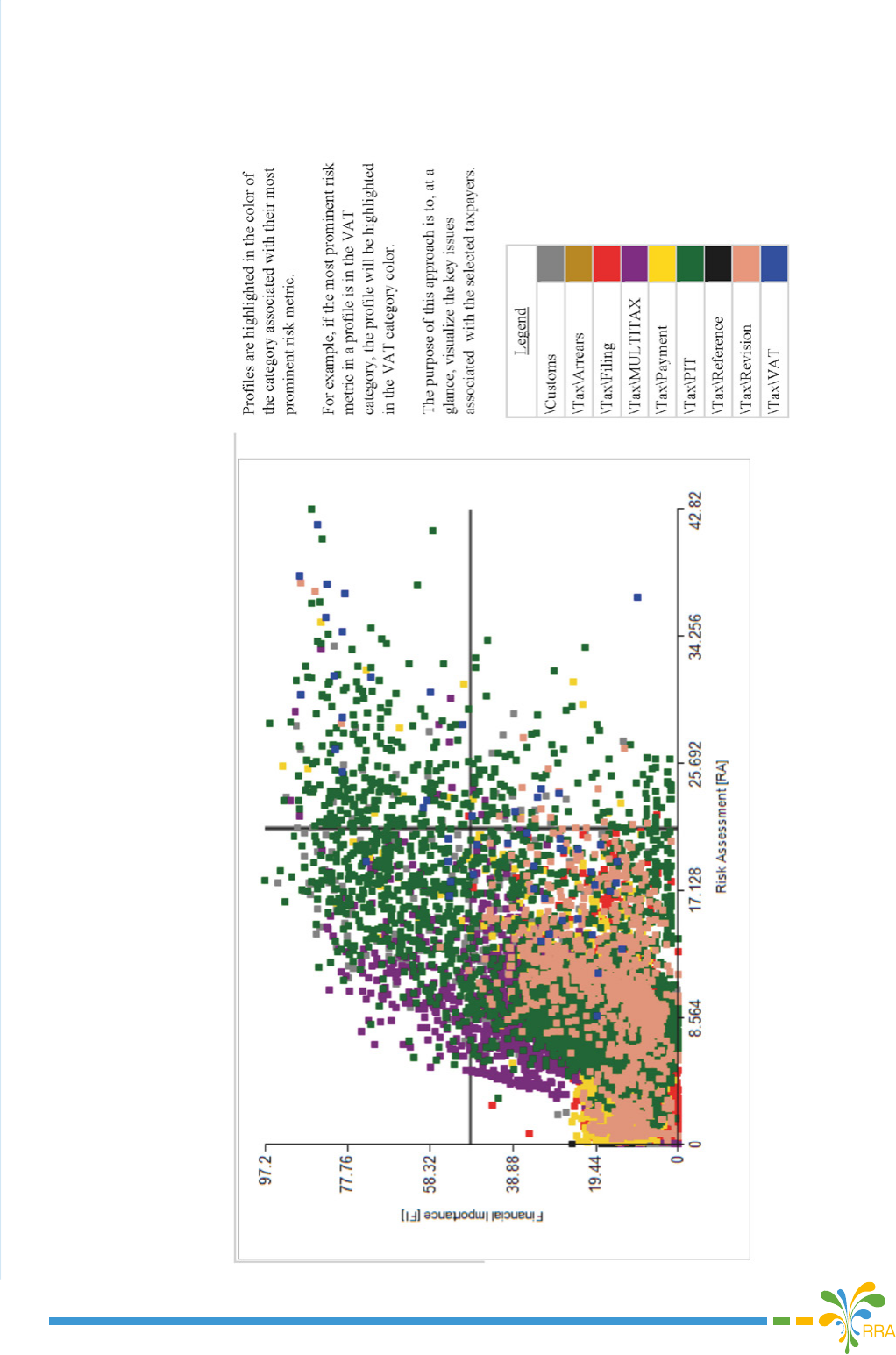
RDF Results for Small Taxpayers
Risk Proles: Individuals (Cross-Sector, Point-Score Basis)
Compliance Improvement Plan
41
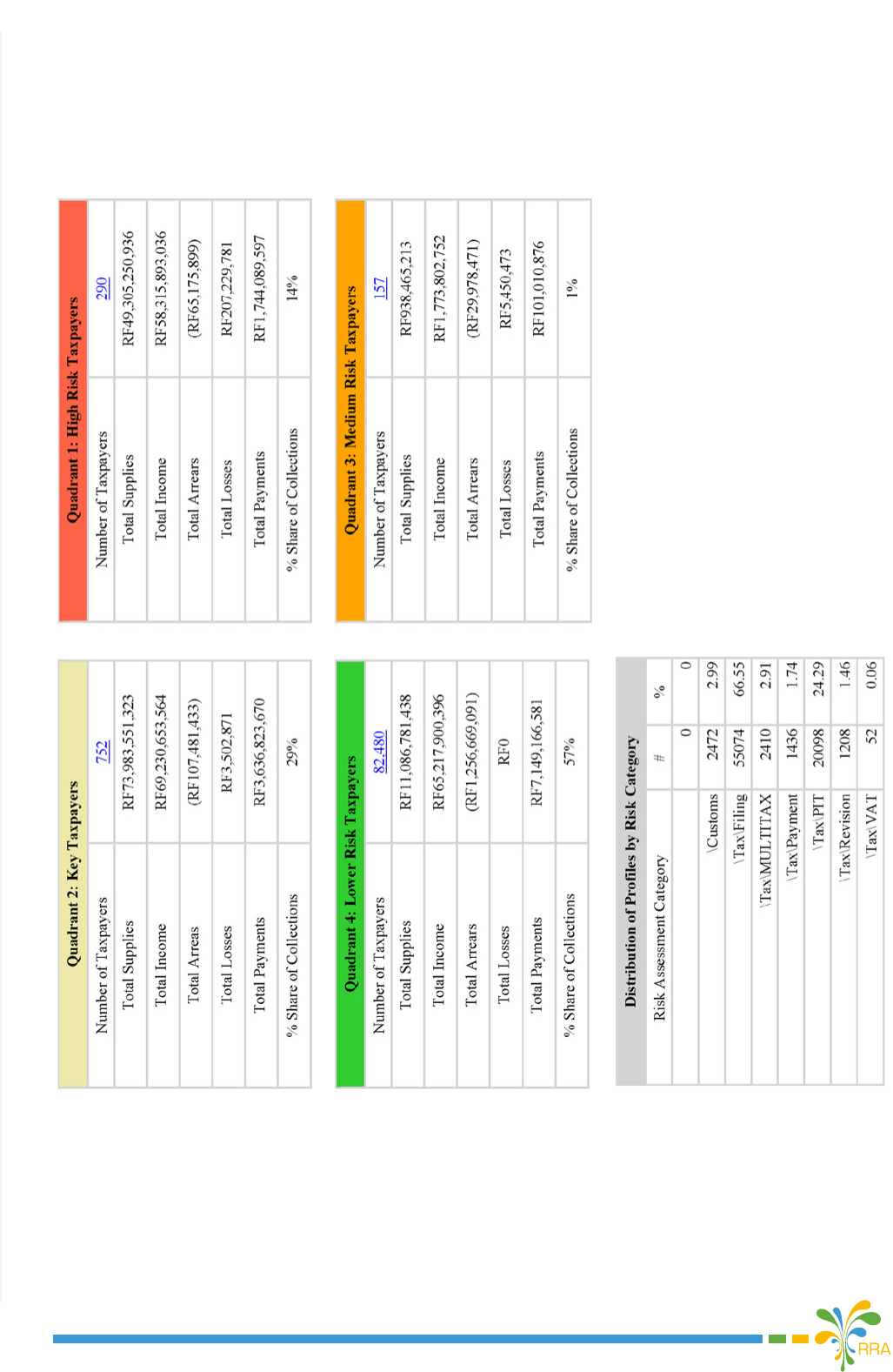
Compliance Improvement Plan
42
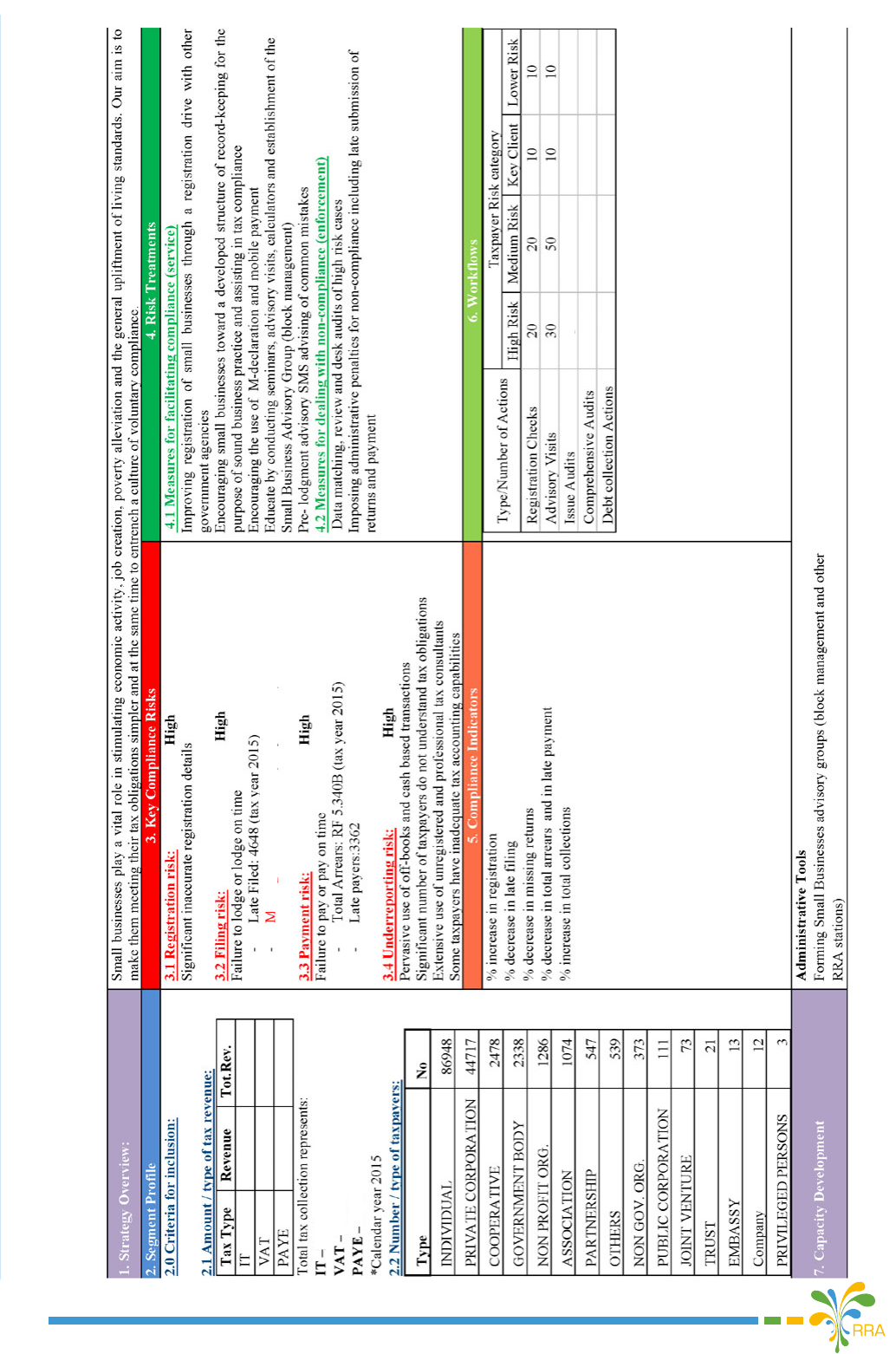
2.2.9. Compliance Strategy: Small Taxpayers
Compliance Improvement Plan
Missing Returns: 136459 (tax year 2015)
43
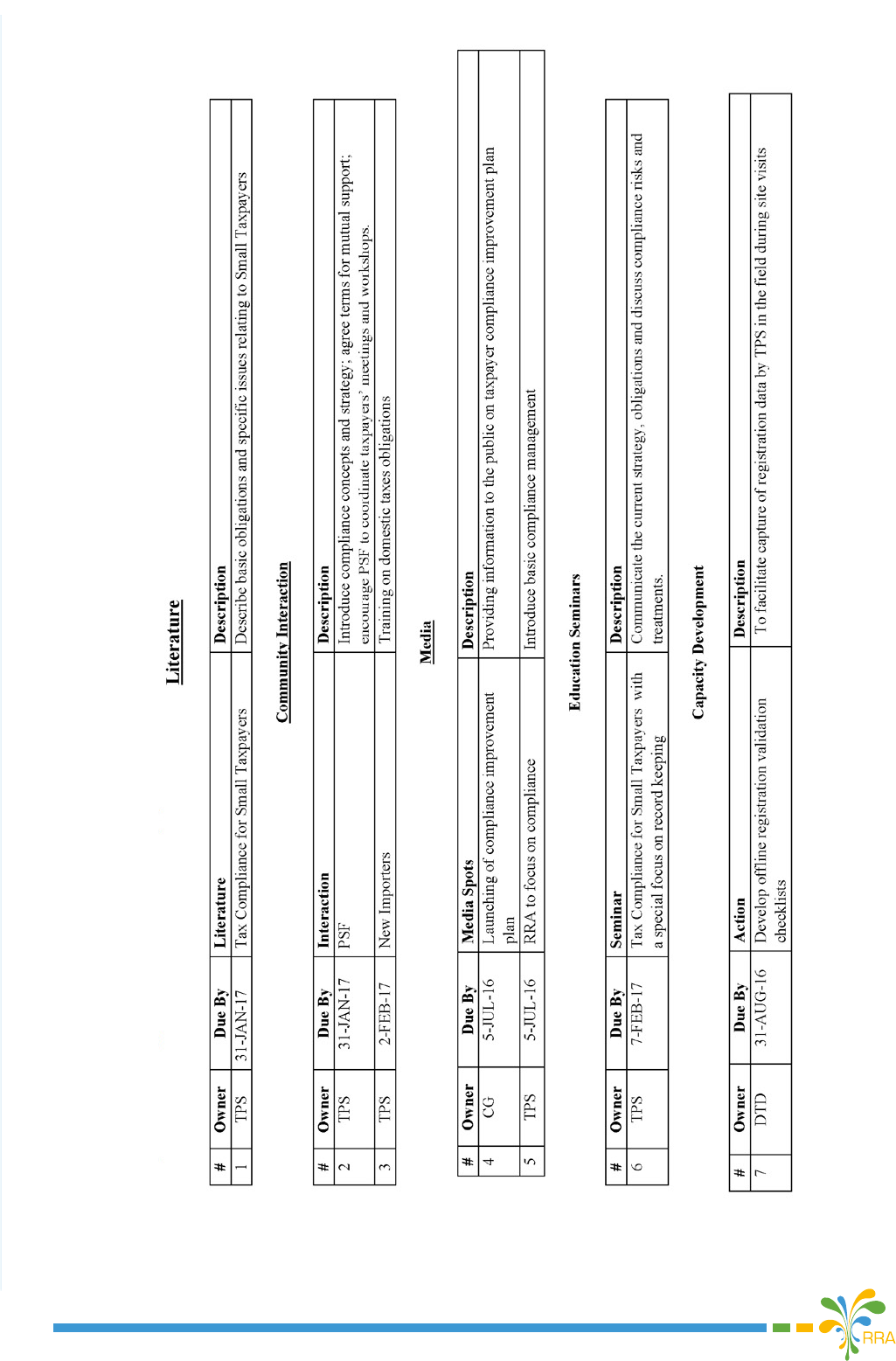
44
Compliance Improvement Plan
2.2.10. Compliance Strategy Action Plan: Small Taxpayers

45
Compliance Improvement Plan
3. MONITORING AND EVALUATION FRAMEWORK
CRMM Department will be conducting a review on the implementation of each activity assigned to the
concerned Department and a report will be submitted to the Commissioner General on a quarterly basis.
The monitoring of performance will be evaluated based on various compliance indicators as described in the
compliance strategy.
4. CONCLUSION
The RRA operates in a complex environment characterized by rapid change. Ensuring compliance, voluntary
or otherwise, in this environment is an ongoing challenge requiring communication, quality services, and
credible enforcement strategies. For the RRA to be successful it must not only continue but also enhance
its partnerships with business in order to encourage cooperative compliance and professional organizations,
identify, analyze and address areas of noncompliance as well as remain innovative in transforming our core
business in a manner that keeps pace with changes in technology, business and management practices, and
the expectations of Rwandans.
APPENDIX
The degree to which the tax administration mitigate assessed risks to the tax system through a compliance
improvement plan.
TADAT requirements for a good Compliance
Improvement Plan
At what extent RRA Compliance Improvement
Plan respond to TADAT requirements
Does the tax administration have a compliance
improvement plan to mitigate identied risk to the
tax system?
A compliance improvement plan has been designed
for the period 2016-2017.
If so, does the compliance improvement plan include
planned mitigation actions in respect of
• All core taxes
• The key taxpayer segments
• Risk associated with the four main compliance
obligations of taxpayers (registration, ling,
payment and accurate reporting in declarations)?
• All risks assessed as ‘High’?
The current compliance improvement plan takes into
account:
• PAYE, VAT, Corporate and Personal Income
taxes
• Hotels and Constructions Sectors are highlighted
as High Risks in dierent segments Large,
Medium and Small in the area of Registration,
Filing, Accurate reporting and Payment
• Areas identied as high risks are taken into
consideration on the Compliance Improvement
Plan with dened risk strategies for mitigation.
Does the compliance improvement plan also cover
less serious risks where ongoing monitoring, rather
than active intervention, is appropriate to ensure
that any further erosion of compliance is quickly
identied?
Registration checks, advisory visits are included
in the compliance improvement plan as actions
to be taken to continuously monitor and maintain
taxpayer’s behavior and attitude for less serious
risks areas.
Does the compliance improvement plan cover multi-
ple years or a single year only?
The current compliance improvement plan covers
one year (2016-2017)
To what extent was the compliance improvement
plan for the most recent completed scal year
actually implemented?
The evaluation of the implementation of 2015/2016
Compliance Improvement Plan will be done during
the 1st Quarter of 2016/2017
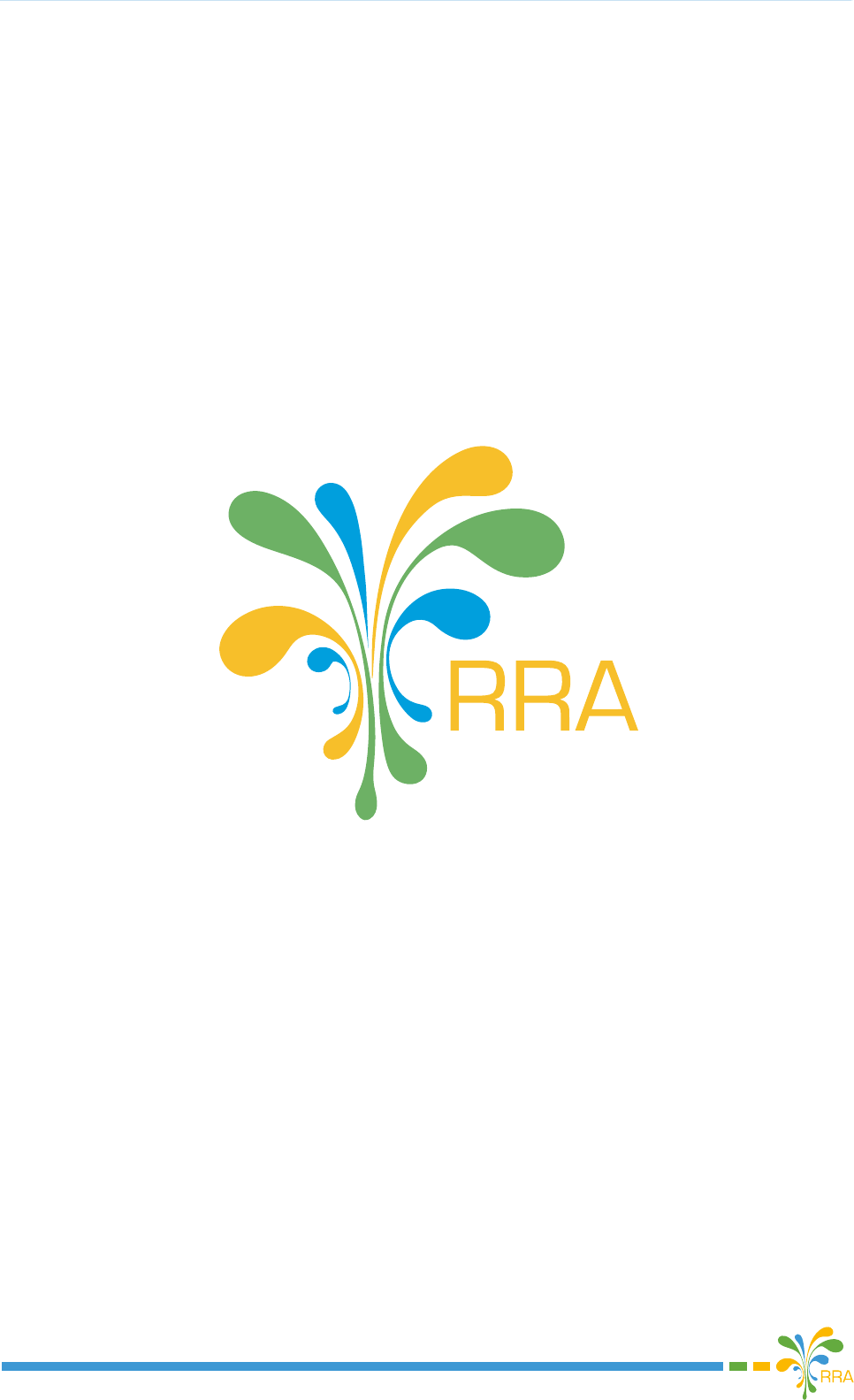
46
Compliance Improvement Plan

47
Compliance Improvement Plan
TAXES FOR GROWTH AND
DEVELOPMENT
RWANDA REVENUE AUTHORITY
Kimihurura, Avenue du Lac Muhazi, Kigali
P.O.Box 3987 Kigali, Rwanda
www.rra.gov.rw
3004
@rrainfo
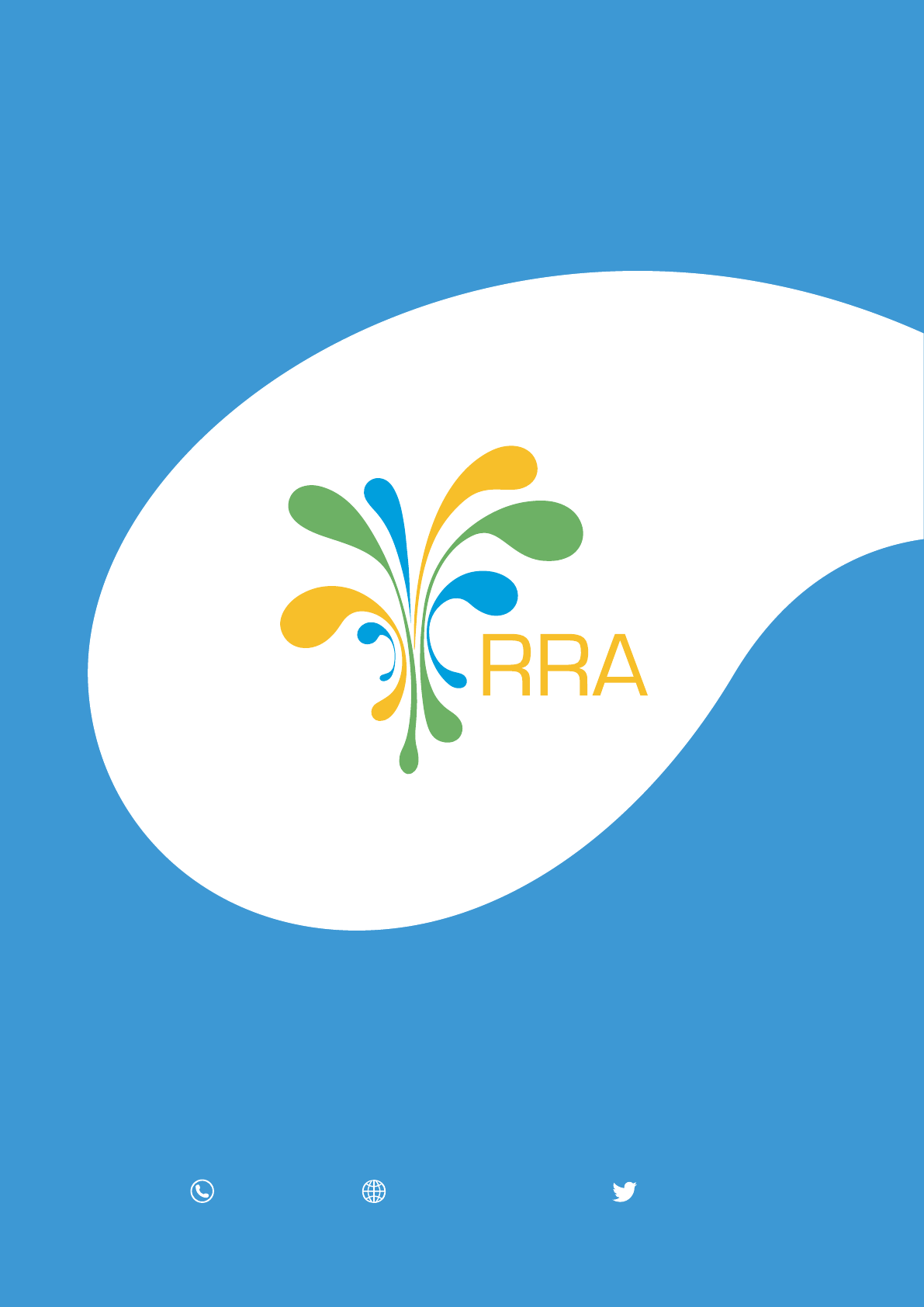
www.rra.gov.rw
3004 @rrainfo
